Aperture's Blog, page 13
December 13, 2024
How Tina Barney Became an Astute Observer of the Upper Class
In the late 1970s, Tina Barney began a decades-long exploration of the everyday but often hidden life of the New England upper class, of which she and her family belonged. Photographing close relatives and friends, she became an astute observer of the rituals common to the intergenerational summer gatherings held in picturesque homes along the East Coast. Developing her portraiture further in the 1980s, she began directing her subjects, giving an intimate scale to her large-format photographs. These personal, often surreal, scenes present a secret world of the haute bourgeoisie—a landscape of hidden tension found in microexpressions and in, what Barney calls, the subtle gestures of “disruption” that belie the dreamlike worlds of patrician tableaux.
This year, Aperture published Family Ties, which collects sixty large-format portraits from the three decades that defined Barney’s career. The volume accompanies the first retrospective exhibition of the artist in Europe at the Jeu de Paume, Paris. Here, in an interview from the book, Aperture’s executive director Sarah Meister speaks with Barney on her beginnings with the medium, the transition to working in color, and her approach to large-format photography and working on assignment.
 Tina Barney with her sister, Jill, and their grandfather, Sands Point, New York, 1956
Tina Barney with her sister, Jill, and their grandfather, Sands Point, New York, 1956  Lillian Fox, Tina Barney’s mother, on the cover of Harper’s Bazaar, August 1940. Photomontage by Herbert Bayer
Lillian Fox, Tina Barney’s mother, on the cover of Harper’s Bazaar, August 1940. Photomontage by Herbert Bayer Sarah Hermanson Meister: I thought we could begin by exploring some of your earliest connections with photography, including the fact that your grandfather was an amateur photographer.
Tina Barney: He photographed us whenever he came over with all different kinds of cameras. I have his 4-by-5 glass-plate negatives from the First World War and some of his photographs.
Meister: Your mother was a model. Do you remember seeing her modeling photographs around the house?
Barney: No, she only showed them to us when we were adults. I think she was kind of hiding them. She stopped modeling when she married my father.
Meister: Did you know she was a model?
Barney: Oh yes. She was incredibly stylish. She brought me to see the collections in Paris where I saw memorable shows, including Yves Saint Laurent’s first fashion show when I was sixteen. So, fashion has really been a part of my life.
Meister: In 1972 you joined the Junior Associates at MoMA and started volunteering there in the Department of Photography. Do you remember when you were first aware of someone who approached photography as an artist, unlike your grandfather for whom it was a hobby?
Barney: When my friend Ali Anderson suggested I become a volunteer, I had barely heard of any fine-art photographers. I knew nothing. My first memory of being at MoMA was when I saw a man showing another man a photograph: It was John Szarkowski showing someone a Ken Josephson photograph. There was a woman there that I befriended and she mentioned Ansel Adams, but I had never heard of him. She started talking about the two photo galleries in New York at the time and that’s how it all began. I went to Witkin Gallery and to Light Gallery. Marvin Heiferman was at Light. Jain Kelly, who worked at Witkin, basically started teaching me the history of photography. That is when I started buying photographs.
 Tina Barney, Marina’s Room, 1987
Tina Barney, Marina’s Room, 1987  Tina Barney, Jill and Polly in the Bathroom, 1987
Tina Barney, Jill and Polly in the Bathroom, 1987 Meister: Do you remember what you were buying?
Barney: Imogen Cunningham, Garry Winogrand, Lee Friedlander, Robert Frank. Just the greatest hits. I have the bills—$150 was the most I spent.
Meister: Pretty good investments. Do you still have the pictures?
Barney: Yes. I also saw the great Friedlander, Arbus, Winogrand exhibition at MoMA in 1967 [New Documents]. It was like seeing God, let’s put it that way. I think it had a great deal to do with the subject matter of Diane Arbus, but also the way these three people were photographing in such different ways. I started looking at photographs more and more, and then I went to Sun Valley and started making my own pictures.
Meister: When you moved to Sun Valley, Idaho, in 1974, you started taking classes at the Sun Valley Center for the Arts and Humanities [now Sun Valley Museum of Art]. What was that experience like?
Barney: The director of the photo department, Cherie Hiser, who came from Aspen, was a sort of goddess—the heroine of photography at that time. She was a combination of Marilyn Monroe and Nan Goldin: a great character. Peter de Lory was my first teacher. And after Peter left, Mark Klett came in to teach color and Ellen Manchester became the director. That is when JoAnn Verburg, Ellen Manchester, and Mark Klett were making their Rephotographic Survey Project. That was very important to me, both because Mark was working with a 4-by-5 camera and because of their commitment to returning to the same place multiple times. They were great teachers.
The setup was quite primitive: you would walk in, in your shorts or ski boots, and famous photographers would come there and teach. It was an incredible environment. Not only did they talk about photography, but about literature, philosophy, and books that I had never even heard of before. So, basically, I was educating myself. I didn’t finish college. I read a lot and learned a great deal besides printing and doing my own work. My own work didn’t really develop there because there was nothing to photograph. It came very slowly after I left.
 Tina Barney: Family Ties 65.00 Tina Barney’s keenly observed portraits offer a window into a rarified world of privilege with sixty large-format works imbued with a spontaneity and intimacy that remind us of what we hold in common.
Tina Barney: Family Ties 65.00 Tina Barney’s keenly observed portraits offer a window into a rarified world of privilege with sixty large-format works imbued with a spontaneity and intimacy that remind us of what we hold in common. $65.0011Add to cart
[image error] [image error]
In stock
Tina Barney: Family TiesPhotographs by Tina Barney. Text by Quentin Bajac and James Welling. Interviewer Sarah Meister.
$ 65.00 –1+$65.0011Add to cart
View cart Description Tina Barney’s keenly observed portraits offer a window into a rarified world of privilege with sixty large-format works imbued with a spontaneity and intimacy that remind us of what we hold in common.
In the late 1970s, Tina Barney began a decades-long exploration of the everyday but often hidden life of the New England upper class, of which she and her family belonged. Photographing close relatives and friends, she became an astute observer of the rituals common to the intergenerational summer gatherings held in picturesque homes along the East Coast. Developing her portraiture further in the 1980s, she began directing her subjects, giving an intimate scale to her large-format photographs. These personal, often surreal, scenes present a secret world of the haute bourgeoisie—a landscape of hidden tension found in microexpressions and in, what Barney calls, the subtle gestures of “disruption” that belie the dreamlike worlds of patrician tableaux.
Family Ties collects sixty large-format portraits from the three decades that defined Barney’s career—accompanying the first retrospective exhibition of the artist in Europe at the Jeu de Paume, Paris. The book includes an essay by Quentin Bajac, the exhibition’s commissioner and director, as well as an interview with the artist by Sarah Meister, the executive director of Aperture, and a text by the artist James Welling. These texts illuminate the artist’s approach to large-format photography, her ongoing interest in the rituals of families, and her personal ideas of composition, color, and the complex relationship between photography and painting.
Tina Barney: Family Ties is copublished by Aperture and Atelier EXB.
Format: Hardback
Number of pages: 176
Number of images: 98
Publication date: 2024-11-14
Measurements: 11.3 x 9.5 x 1 inches
ISBN: 9781597115889
Tina Barney (born in New York, 1945) is an American photographer best known for her large-scale color portraits of family and close friends in New York and New England. Her books include The Europeans (2005), Players (2011), and Tina Barney: The Beginning (2023). She lives in New York and Rhode Island.
Quentin Bajac has been director of the Jeu de Paume since 2019, after having been the head of the Photography Department at the Museum of Modern Art in New York from 2013 to 2019 and curator for photography at the Musée National d’Art Moderne–Centre Pompidou from 2007 to 2012.
Sarah Meister is executive director of Aperture, following more than twenty-five years at the Museum of Modern Art, New York, where she curated numerous exhibitions, including Fotoclubismo: Brazilian Modernist Photography, 1946–1964 (2021), Dorothea Lange: Words & Pictures (2020), and Making Space: Women Artists and Postwar Abstraction (cocurator, 2017).
James Welling has produced a continuously evolving body of images that engages the history and technical parameters of photography. He is a recipient of the Infinity Award from the International Center of Photography, New York, and teaches at Princeton University, New Jersey.
Meister: Like most photographers in the 1970s, you began working in black and white. Why was that, and how did you decide to shift to color?
Barney: I have a feeling that the change might have come from color being a fad at that time. When I was making black-and-white work, it really was like speaking another language. I would actually think about the transfer into black and white, I would imagine it in my mind. With black-and-white photography you’re dealing with tones and shadow, or light and dark, as opposed to color. I feel like color is a more natural translation of reality.
Meister: So you don’t make that translation when you’re working in color?
Barney: No. Actually, it’s something I don’t think about. This is what it might be like: English is my native language and when I speak it, I don’t do a translation. But if I speak French or Italian, there’s a translation going on in this section of my brain, which fascinates me. I think that is what happens when I’m photographing in black and white.
Meister: Let’s turn to the question of format. What camera do you use?
Barney: Well, for almost as long as I can remember, I have photographed with a large-format camera. Those earliest pictures were 35mm, and I don’t think that I’ve gone back since 1982, except in moving imagery, which is a whole other topic. Large format is really my native tongue. It’s so much a part of me, it’s automatic for me now. One of the best parts about it is that it slows me down. I have a very fast- moving personality, which might sound great, but it’s not: I badly need to slow down. Those view cameras really do slow you down, which means thinking. I love the 8-by-10 because when I go under that dark cloth, it’s like a meditative process, which is just not part of my personality. Even though there might be other people around me, I concentrate when I’m under that dark cloth.
 Tina Barney, The Magician, 2002
Tina Barney, The Magician, 2002Meister: How did you learn to work with a 4-by-5 camera?
Barney: I must have gone out and bought one right as I was leaving Sun Valley. When I left, I knew nothing about that format, and I had no teachers and nobody to ask. I don’t even know how I learned to use it—the same Toyo camera I have today—when I got to New York. In the beginning, I had the rail of the camera showing in the picture because I didn’t even know how to open it up. I really did it by trial and error. I don’t remember how I got the film developed or where it was printed or any of those things.
Meister: You have spoken about learning to make larger prints in Sun Valley . . .
Barney: Peter de Lory taught us how to do that in black and white and Wanda Hammerbeck came in and talked about a lab in Berkeley that Richard Misrach used to make 30-by-40-inch color prints. Around that time, I went to Houston and met Anne Tucker [then photography curator at the Museum of Fine Arts]. She told me about a place where they could make an even bigger print—48-by-60 inches. It was a really big deal to do that. Before that I don’t think the paper had been invented. That’s when everything started happening.
Meister: Tell me more about meeting Anne Tucker.
Barney: I went to Houston [from Sun Valley] with another friend who was a painter. She wanted to become famous, too. When we saw Anne, we rolled the prints out on the floor. She said, “Wait a minute,” and then ran out in the hallway and started getting everybody in the department to come in and said, “You’ve got to see these pictures.” Then she phoned her friend Marti Mayo who was working at the Contemporary Arts Museum in Houston and said, “Marti, you’ve got to come over and see these.” I sat there and said, “OK, I think I’m dreaming,” because that is what every artist in the universe dreams of.
Anne said, “You’ve got to call this guy John Pultz at MoMA. He’s having a show about big pictures.” I called MoMA and said, “Hi, I have a picture I’d like to show to you.” I don’t know how I even found the phone number. While I was on vacation with my kids, the phone rang and it was John Pultz. He said, “We’d like to show your picture [Sunday New York Times] at the Museum of Modern Art.”
I didn’t even go to the opening because I was in Sun Valley. I never saw it hanging there. That’s how it happened.

Tina Barney, Sunday New York Times, 1982
var container = ''; jQuery('#fl-main-content').find('.fl-row').each(function () { if (jQuery(this).find('.gutenberg-full-width-image-container').length) { container = jQuery(this); } }); if (container.length) { const fullWidthImageContainer = jQuery('.gutenberg-full-width-image-container'); const fullWidthImage = jQuery('.gutenberg-full-width-image img'); const watchFullWidthImage = _.throttle(function() { const containerWidth = Math.abs(jQuery(container).css('width').replace('px', '')); const containerPaddingLeft = Math.abs(jQuery(container).css('padding-left').replace('px', '')); const bodyWidth = Math.abs(jQuery('body').css('width').replace('px', '')); const marginLeft = ((bodyWidth - containerWidth) / 2) + containerPaddingLeft; jQuery(fullWidthImageContainer).css('position', 'relative'); jQuery(fullWidthImageContainer).css('marginLeft', -marginLeft + 'px'); jQuery(fullWidthImageContainer).css('width', bodyWidth + 'px'); jQuery(fullWidthImage).css('width', bodyWidth + 'px'); }, 100); jQuery(window).on('load resize', function() { watchFullWidthImage(); }); const observer = new MutationObserver(function(mutationsList, observer) { for(var mutation of mutationsList) { if (mutation.type == 'childList') { watchFullWidthImage();//necessary because images dont load all at once } } }); const observerConfig = { childList: true, subtree: true }; observer.observe(document, observerConfig); }Meister: Let’s talk about Sunday New York Times, which you made less than a year before it appeared in that exhibition.
Barney: You know, when I look at that picture—I just looked at it the other day, I don’t see it often—the resolution is so incredible. That’s what is amazing. I don’t know how I did it because there are ten people in the picture and they’re all running around like crazy idiots. I asked the father to sit at the head of the table, I counted one thousand, two thousand, three thousand . . . and he held still. That was just enough. I had no idea what I was doing counting those seconds. I was so untechnical: I just guessed.
Meister: About the gallerist Janet Borden . . .
Barney: I have to mention Janet because she is definitely the most important person in my career. You know how people say someone made them? She made me. She had the imagination and the personality to put me in a context I think I could have totally missed. She knew the most far-out people. She went to Smith College, she was friends with actors that worked in The Wooster Group, she went to Rochester Institute of Technology. Every person she introduced me to was cool and happening. I think that was very important because I could have been put in this category of “nice little portraiture,” you know?
Meister: How did you meet her?
Barney: She worked for Robert Freidus, and I must have heard about his gallery somehow. I bought a couple of pictures from her. Then, when I had the big pictures, I think I called her and said, “Would you like to look at these?” It took her a long time to get her own gallery, so at first she showed them out of her little apartment. One show was in a restaurant of a friend of hers, tacked up on the wall. Another was in a gallery, and you had to walk through another show that was so terrible to get to my show. I went to the opening and thought, Oh my God, I’m going to die. She introduced me to everyone. She knew all the curators and everybody in the photo world.
Meister: So, when your work was included in the Whitney Biennial in 1987, you had been working with Janet for a while?
Barney: I was very lucky because I was in quite a few shows in the 1980s, but the Whitney Museum was a big deal. My best friend in Sun Valley, Mary Rolland, who ran a gallery there, said, “You’ve got to show your work at the Boise Gallery of Art” [now Boise Art Museum]. I replied, “Oh, don’t be ridiculous,” but I sent Beverly, Jill and Polly and Sunday New York Times and they took them both. Patterson Sims was the judge and he gave me first prize. He was then a curator at the Whitney, and Lisa Phillips was also there. They took three of my pictures for that Whitney Biennial. The Starn twins [Doug and Mike] were in it too; it was an interesting show.
 Tina Barney, Two Sisters, 2019
Tina Barney, Two Sisters, 2019  Tina Barney, spread of Connoisseur, March 1988, from “Issey Miyake Is Changing the Way Men View Clothes”
Tina Barney, spread of Connoisseur, March 1988, from “Issey Miyake Is Changing the Way Men View Clothes” Meister: Shortly after the Biennial you did your first editorial assignment.
Barney: I think that was with Connoisseur magazine, which was fantastic. That came from Janet too. She knew the guy who was on the cover of it with Polly, my niece. The photograph was taken in my sister’s apartment. It was terrific. Issey Miyake clothes. I used my son in another picture. We had a blast. That was the first shoot I ever did and I was really nervous, but I loved it. In 1990 Michael Collins, one of my dearest friends who is now a photographer, was the picture editor of the Daily Telegraph magazine. He hired Larry Sultan, Philip-Lorca diCorcia, me, and many others to do editorial jobs all over the United States. I worked for him for a long time and it branched out into many more things. That was when I really started doing editorial work and I loved it. He sent me on the weirdest jobs you could ever imagine.
Meister: Bill Brandt once observed: “I hardly ever take photographs except on an assignment. It’s not that I do not get pleasure from the actual taking of photographs, but rather that the necessity of fulfilling a contract—the sheer having to do a job—supplies an incentive, without which the taking of photographs just for fun seems to leave the fun rather flat.” I feel as if I’ve heard you say something similar.
Barney: Well, that’s exactly how I feel. It’s almost like having an assignment in school that you enjoy and really want to do. Anyone who’s not an artist does not realize what it’s like to be an artist. You don’t jump out of bed every day and think, Oh boy, I have a lot of great ideas and I can’t wait to get out there. I always think you have to make inspiration come. You really sit around and start to think, What should I do every day?—which is not the most fun part of making art. The longer you keep doing it, the harder it gets to reinvent yourself each time. I’ve been lucky enough to do what I want and I really do enjoy it. Some of the pictures have ended up being really strong and some haven’t. But most of the time, because I’ve had such good choices, I’ve really enjoyed them.
Meister: Is it important to you that someone can tell whether a photograph was made on an editorial assignment?
Barney: No. To me they fit right in. The fact that they are from an assignment is like having an extra-spicy sauce on top of dinner. They’re a fun added attraction.
Meister: I’d like to ask you about the decision to shoot analog or digital.
Barney: When I first started using a digital camera in 2014, I did it because I thought, OK, this is what’s happening in the world and I sure don’t want to be out of it. I’d better damn well figure out what this is all about. I struggled with it. I made pictures, most of which were not successful at all. Now, when I do a fashion or commercial job, I struggle with my assistants, my agent, and the clients because they all want me to use film! This just started happening four or five years ago. I thought everybody was crazy: They don’t know the difference. Now it’s the first thing people ask, “Will she use film?” They don’t know the pain in the neck it is—let alone the cost—all the other equipment, plus a lot of other things, including finding an assistant who knows about view cameras.
I love the 8-by-10 because when I go under that dark cloth, it’s like a meditative process.
Meister: What do you think they’re after?
Barney: The main thing is they want my pictures that I’m doing for them to look like my own work. They think what defines my own work is the camera and film I’m using. I still think they’re crazy, but sometimes, I think they’re right. There are a couple of things you’re not going to get if you digitize that 4-by-5 or 8-by-10 negative. You’re not going to get that sort of edge—edges that are so sharp and fine and sort of false-looking. The other thing is that I think people don’t realize how much is out of focus in my view-camera work—and has been for the last forty years.
Meister: When you’re working with a digital camera, that kind of thing is not possible?
Barney: Right. There’s a softness to it. There’s also a color difference. There’s a pastel look to analog film. But it’s very hard to explain without actually looking at the image in front of you.
Meister: Could we talk about moving images for a moment?
Barney: Super 8 films are my really great love; they are very close to my heart. I always feel like a beginner and I’ll never get past that. If I had my way, I would just take the film and say, “Here, take it. This is what I love. We don’t need to make any sense out of it. There doesn’t have to be a story. I just love the way this looks.” This kind of vintage look is what I really love. I’ve tried to make many little films and I don’t think they’re successful or important, but I love the fact that they might be shown. Actually, one film that’s going to be shown at the Jeu de Paume is a VHS. So much time has gone by that it actually looks great. I mean, it’s just a mess. Forget about focus. I had this prehistoric sound system. I had no idea what I was doing, but I did it.
 Tina Barney, The Lipstick, 1999
Tina Barney, The Lipstick, 1999  Tina Barney, Family Commission with Snake, 2007
Tina Barney, Family Commission with Snake, 2007 Meister: What did working with a moving image offer?
Barney: Because I just love looking at film. It’s like when you see something you like you say, “I want that too. I want to have that dress or make a cake that tastes like that.” It was basically that I wanted to try it. I also thought about recording the people I was photographing: imagine if you could hear what they were saying—not only because I’m so in love with anthropology and sociology—their accents, the intonation, the way they treat each other. That is all part of it.
Meister: You’ve also made digital videos. What interests you about those?
Barney: I have one film called Youth [2016–18] in which I filmed the same identical twin boys, following them year after year. That film is a combination of digital, Super 8, and some stills, even an 8-by-10. When you look at the same subject matter with a different medium, do you feel differently about that subject? That’s what interests me.
Meister: In 1990, seven years after you showed your first picture at MoMA, Catherine Evans did a solo exhibition of your work there. Do you remember how that came about?
Barney: I don’t, but it was pretty unusual. I felt like it was pretty early to give me a show. It was very much the greatest hits of what I had done up to that point. After that, other museums in the United States gave me shows. This all has to do with Janet and her connections because she knew so many people in all those museums: Columbus, Cleveland, Denver. They all bought my work and gave me shows, mostly Theater of Manners work.
Meister: I love capturing what a great dealer can do for an artist’s career.
Barney: This was it, especially at that time. A lot was happening, very, very, quickly.
Meister: Were you there for that MoMA opening?
Barney: Oh yes, I was. I remember getting my hair done and the hairdresser did the worst kind of Toulouse-Lautrec [updo]. I remember Janet’s face when I walked in. When I look at the snapshots, I think, Why didn’t I take it down? Luckily, I was so young and thin and I had a beautiful dress on. But I don’t know why I didn’t just tear it down.
Meister: Let’s jump forward a bit, to your next major body of work. What made you decide to go to the American Academy in Rome?
Barney: That’s very simple: Chuck Close and Dorothea Rockburne. Both said, “Tina, you’ve got to go and apply.” I kept thinking about it but thought it was too crazy. Then, by chance, a friend of mine, who is also from Sun Valley, had an Italian friend who lived in Rome. I met her as she also lived on the East Coast here and traveled back and forth. It was love at first sight. I knew that I had a friend there that was going to help—that woman really was the beginning, the creator. I couldn’t have done The Europeans without her. Bob [Liebreich, Tina’s partner] and I went together and lived at the Academy. We went three different falls [1996, 1997, 1998], but she supplied the friends. What I had not realized is that sometimes Italians marry different nationalities. They would say, “Oh, I have a cousin in this country, I have a nephew in that country,” and that is how it dominoes into other countries.
 Tina Barney, The Two Students, 2001
Tina Barney, The Two Students, 2001  Tina Barney, Nuevo Mexico, 2003
Tina Barney, Nuevo Mexico, 2003 Meister: Will you talk a little bit about The Europeans?
Barney: As with all my projects, at first I never thought something would come of it. Bob was my assistant. When I got to the first location, it was so beyond anything I could have ever imagined in fifty-thousand million years, I thought, Oh my God. For the picture Father and Sons, it was really like central casting had come in and done a set for me. Every time I met another person, they introduced me to another person, and it would just get better and better. It was eight years of bliss. In some countries, it was more difficult finding people—I don’t speak German, for instance. It makes a big difference to speak the language.
Meister: Do you think that that would have been different if you had been approaching American strangers?
Barney: Gosh, I never thought of that. But, you know, you can’t even compare because quite a few of these people were nobility. Some Americans think they’re nobility but boy, there’s a difference. I’ll tell you what it is. The act of having your portrait made was so much a part of their culture and their heritage that it was a very normal thing for someone to come in and make their portrait without knowing them. The beautiful part—and I noticed this on that first picture—was that I could not direct these people or tell them what to do. Not because of the language, but just because of the way they were. They held poses that I think are subconsciously handed down from generation to generation, for the sake of the portrait. I don’t know if I’m making that up, but I felt it, and right away the pictures became more formal, or static. The resolution was so beautiful, because for once people weren’t moving around, out of the plane of focus. When I started printing, they were better than any picture I’d ever made in the sense of quality of focus and color and eventually lighting—the lighting was just like a joke in the beginning.
Meister: You resist characterizing the subjects of your portraits in your titles, yet you once said, “I know now that before I take a picture, I have to be sure how I feel about the subjects.” Do you still feel this way today?
Barney: That depends so much on the situation. It has to do with whether it’s a job and because I don’t really photograph people I know well anymore. Youth is probably the last time I photographed people I knew well, although not as well as the pictures in Theater of Manners, because they weren’t my children, brothers, or sisters.
Advertisement
googletag.cmd.push(function () {
googletag.display('div-gpt-ad-1343857479665-0');
});
Meister: Did photographing The Europeans change the way you would approach that statement?
Barney: Absolutely. That project was so very different. It was people I didn’t know at all. Sometimes I didn’t speak their language. I was in a foreign place, thinking about portraiture in a different way than ever before. Most of the time it was formal or visual in The Europeans.
Meister: To the question of artistic communities, do you feel that you’re a part of one?
Barney: I don’t ever feel like I was part of a photo or art group. I was in Sun Valley because we were all stuck in that little place, but since I came back here [to the East Coast] I’ve really been on my own. Larry Sultan was a really, really good friend. I met him through Janet Borden because we both showed there. We had the most in common of any photographer I’ll ever meet. We just knew that what we were doing was deep down the same thing, and we were tortured by the difficulty of what we were doing. But most of the time, I didn’t really hang out with other photographers.
Meister: What about Mitch Epstein? How did you become friends?
Barney: My friend Judith Freeman said, “You should meet Mitch Epstein,” and I called him up and said, “Let’s meet.” I actually introduced him to his wife, so yes, we’re very good friends. He is the kindest, most generous person you could ever find. Some artists are very protective of what they do in many different ways, and Mitch just isn’t. He’s always the person I call.
 Tina Barney, Graham Cracker Box, 1983
Tina Barney, Graham Cracker Box, 1983  Tina Barney, Ada’s Interior, 1981
Tina Barney, Ada’s Interior, 1981All photographs © the artist and courtesy Kasmin, New York
Meister: You are not a big self-promoter. You are, dare I say, a little shy. And yet for Theater of Manners, you appear in more than twenty photographs. That was a pretty big chunk of your first book.
Barney: I can’t remember why I thought that was important. You’re right, because that was sort of unlike me. But I think that book had a lot to do with the editor Walter Keller, who kept on saying, “More, more, more.” He was brilliant, absolutely brilliant. I’m so glad I did it.
Meister: You and I got to know each other better through August Sander: you were the first person to speak at the five-year research initiative Noam Elcott and I convened. You set the tone in such an unexpected and moving way because you mused about August Sander as a human, noting that “every word you say, every move you make, reflects on that photograph.” I’d like to ask you to think about August Sander in the context of this exhibition of your portraits.
Barney: I love his work: the purity of it, the simplicity. Really, portraiture is my great love. When I say portraiture, I mean someone just standing there with nothing around, doing nothing, just looking straight into the camera. About as simple a picture as you could take. The complexity of that, the investigation into a human being by using that machine—those two things together, to me, are the ultimate, and the most difficult.
Meister: Hearing this brings to mind some of your self-portraits, where it’s just you and the camera, almost wrestling with one another.
Barney: I think if we look through the history of art, self-portraits are probably the most important works an artist makes. Probably because you know yourself the best. I think photography is the most difficult medium to use to do this. Of course, others that use other mediums would probably say their medium is the most difficult. The camera has the problem of focusing. How do you focus on yourself? Well, there are different tricks, but it’s damn hard to do. Also, what you’re thinking about when you take the picture. To me, that’s probably the most important thing of all, what you decide to think about.
Meister: Because you think you can see that?
Barney: Well, you should be able to. You hope you can. And then can you answer that question yourself, too? Who am I? What am I?
Meister: I’m curious to hear what you think of “environmental” portraits, which I consider an important piece of your oeuvre. I’m surprised to hear you say that somebody without anything around them is the purest form of portraiture.
Barney: That is because it’s the most difficult.
Meister: But it doesn’t seem to me like you’re taking the easy way out with the other ones . . .
Barney: The more stuff in a space or a room for me, the easier it is. The more minimalistic a space is, the more difficult it is, because then you have to work harder. You’ve got to think about that figure and what to do with it.
Meister: I’d like to conclude by asking how you feel about being an artist, despite your not-so-bohemian upbringing?
Barney: I actually really struggle to say that I’m an artist. Well, first of all, I feel like that’s such a phony thing to say. Then again, it’s just so much a part of me that I don’t feel like it’s a separate thing.
This interview originally appeared in Tina Barney: Family Ties (Aperture/Atelier EXB, 2024).
Charlie Engman Transforms the Internet’s Murk into Art
All photographs come from somewhere—are of something. At least that’s still the premise, even as AI-generated pictures suffuse the world. A cursed image, then, is one without context: someone slicing sausage with a bootleg Windows XP disc, a motorcycle tucked into a bed, so much wayward spaghetti. From nowhere, going nowhere; a scratch in the feed.
“They feel like products of the deep internet that have this authorless, golem-like quality,” Charlie Engman says of his recent work. “Images that have taken on a life of their own, that seem to have been created from the murk of the internet rather than by any one real scenario.” His new photobook is duly titled Cursed (2024).
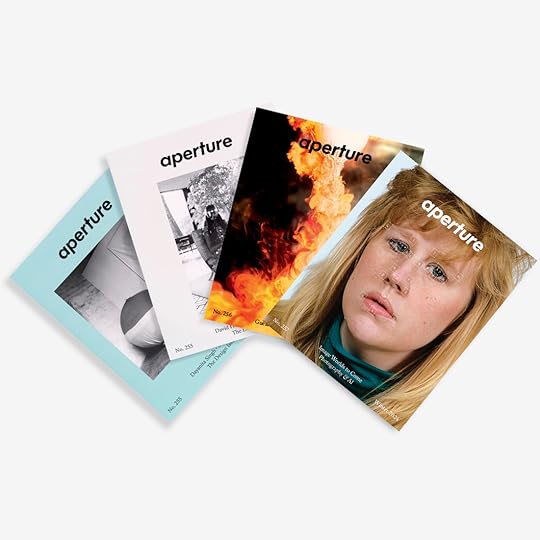 Aperture Magazine Subscription 0.00 Get a full year of Aperture—the essential source for photography since 1952. Subscribe today and save 25% off the cover price.
[image error]
[image error]
Aperture Magazine Subscription 0.00 Get a full year of Aperture—the essential source for photography since 1952. Subscribe today and save 25% off the cover price.
[image error]
[image error] 
In stock
Aperture Magazine Subscription $ 0.00 –1+ View cart DescriptionSubscribe now and get the collectible print edition and the digital edition four times a year, plus unlimited access to Aperture’s online archive.
Engman is typically a camera-using, straight-ahead photographer, perhaps best known for a lengthy series of revealing, bare portraits of his photogenic mother. In the last two years, though, he’s become something of an AI whisperer, employing Midjourney, DALL·E, and their ilk of generative AI programs to dredge the internet. He plumbs the mushy, statistically average but practically unreal quality that makes AI-generated pictures derivative and bad until he finds something compelling: Body horror. Misbegotten hugs. Ceramic or part-human swans wading knee-deep in impossibly shallow parking lot puddles. Waxen human-approximates crumpled on bedcovers. The interface—where people touch objects and one another, where light touches an object—is the place in which AI miscarries.
Drawing on reservoirs of sleazy hard flash, incidental still lifes, and pickling Polaroids, Engman leans into these pictures being photographs, assembled from whatever clots of photographic data float through the internet’s sewer. “I feel like, weirdly, this work is the most photographic work that I’ve ever made,” he states. In his previous output, he was trying to push and bend photography’s conventions, its history. With the AI images, “I actually felt like I was running toward photography to see how close I could get,” he says, “and what that kind of closeness would mean in this new context.”
 Charlie Engman, A Cliff Overlooking Water, 2024
Charlie Engman, A Cliff Overlooking Water, 2024  Charlie Engman, Boy Glint, 2024
Charlie Engman, Boy Glint, 2024 Are his pictures technically photographs? It’s hard to say, but their source images are, or, somewhere down the line, were. Engman’s pictures draw on a latent, ghostly indexicality, the sense that light touched something, a piece of something, bounced into a lens, and now the software is doing its best impression of that light.
The images in Cursed derive primarily from Midjourney, although a few incorporate Engman’s custom models or photographs he made. It was important to him to use accessible technology. In the spirit of the “cursed” genre—popularized on Tumblr in 2015 to describe certain lo-fi photographs with an unintentional creep factor—you don’t need special training (though maybe a taste for the uncanny) to pull the most haunted accidents. This sifting is part of Engman’s process. From a slough of trawled pictures, the software replies to each prompt with four composites. He’ll feed in his own images, add both language and image prompts, and process the pictures again and again until they eke that cursed look.
Advertisement
googletag.cmd.push(function () {
googletag.display('div-gpt-ad-1343857479665-0');
});
The square format, the nostalgic default of Instagram via the Polaroid instant camera, is also the standard for text-to-image models. Photobook aficionados, perhaps allergic to social media’s rigid conventions, “really balked at the fact that I was making a square book,” Engman tells me. The square is too basic, too accessible—which, he continued, illuminates a tacit line of critique of AI: that it is undermining the rarefied conventions of fine art (as well as scraping images without permission). The availability of cursed images is part of their threat: Simply by dipping into the mainline, you can find something that surpasses the most studied fine-art photograph for punchy strangeness.
Engman grants that there’s something a bit perverse to having made a photobook out of this material. A binding elevates and fixes the content it contains, marking a particular state of the art even as technology rushes on. It is all the more contrarian to pause images that might have had no destiny. Engman is standing in rushing waters. He described perusing images he’d generated not two years ago and finding them outdated, the quirks of early AI (extra fingers, mismatched eyes) already digested by pop culture.
“I became excited by this idea that you could be nostalgic for the present,” he says. “There’s an experience of things moving at such a scale that you couldn’t even be present with what you were making because you are already anticipating it becoming valueless or irrelevant.” The project, of course, also pokes at the notion that AI itself is a cursed invention, rushing to the world’s end. “Does interaction with the technology curse the user?” he muses. “Does it curse the author? Does it curse the viewer?” Engman’s recent pictures ooze from our AI-crazed moment but also float free of it. Consider yourself cursed.
 Charlie Engman, Watermelon, 2024
Charlie Engman, Watermelon, 2024  Charlie Engman, Swan III, 2024
Charlie Engman, Swan III, 2024  Charlie Engman, Leaves, 2024
Charlie Engman, Leaves, 2024  Charlie Engman, Ants, 2024
Charlie Engman, Ants, 2024  Charlie Engman, Bedroom Animal II, 2024
Charlie Engman, Bedroom Animal II, 2024  Charlie Engman, Hand to Chest, 2024
Charlie Engman, Hand to Chest, 2024All images courtesy the artist
This article originally appeared in Aperture No. 257, “Image Worlds to Come: Photography & AI.”
December 6, 2024
A Photographer Captures the Experience of Dispossession in Turkey
Cansu Yıldıran was born in 1996 and spent the first seven years of their life in Çaykara, a town in the Kuşmer Highlands, in northern Turkey, on the Black Sea. As a teenager, they found photography, and began taking self-portraits on a smartphone, posing for androgynous images, savoring the medium’s genderqueer potential. They enrolled in photography school in Istanbul and purchased a digital SLR, a Fujifilm, using their mother’s credit card without her knowledge. (This caused a fuss, but their mother said she’s glad they stole the card.) At age seventeen, Yıldıran began shooting the images that would form two ongoing series, The Dispossessed and The Shelter.
Yıldıran’s images are polyphonic; their projects overlap. Many photographs are rich with autoethnographic elements. The Dispossessed contains dimly lit scenes captured in the Black Sea mountains and valleys of their ancestry. In darkness, a flashlight exposes a rural woman or a detail in the landscape with such brightness that it turns them into surfaces with newborn vitality. Yıldıran uses flashlights extensively “because this is what women who work and live in those mountains do.” In one image, a woman appears faceless against a dark background. Yıldıran had instructed her to point the flashlight to her face. “I cherish the performative aspect of photography,” they told me.
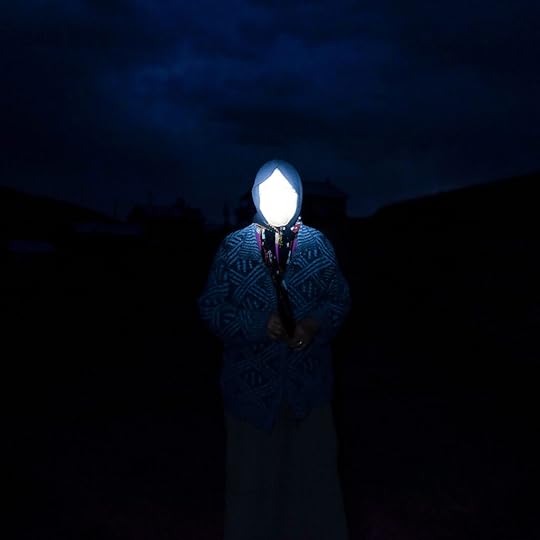 Cansu Yıldıran, from The Dispossessed, 2016
Cansu Yıldıran, from The Dispossessed, 2016Yıldıran spent many summers returning to and taking pictures of Çaykara, or “lower village,” which lies in a V-shaped valley in the Pontic Mountains. Nomadic Turkish tribes, Armenians, and Greek-speaking Christians populated the region for centuries. Traces of its history as part of the Byzantine, Trebizond, and Ottoman Empires remain. In 1915, during the Caucasus Campaign of World War I, the Russian Army invaded. The ensuing decade saw the Ottoman extermination of some three hundred and fifty thousand Pontic Greeks. Today, Çaykara has a population of about twelve thousand.
On their visits, Yıldıran tried to embrace and understand the place. Portraying women and animals that for centuries formed “an alliance of mountain creatures,” they said, was a means of announcing, “We’re here to ponder the memory of our homeland.” Yıldıran joined their mother, aunt, and other relatives as they picked nuts. Taking pictures, walking around, and trying to be helpful proved therapeutic. The fog that covered the view created sublime landscapes. A woman burns fallen leaves; four women pray before lunch; a goat is milked in a barn.
In this fairy-tale land, Yıldıran’s dreamy images capture a historical process of dispossession. Yıldıran’s mother, who studied dentistry before returning to her hometown, couldn’t own a house because of an old custom that says only men could buy property there. “I realized my work was about being guests for life. About the desire to belong to a place but being rejected by it.” (The Kuşmer Highland is deeded to 373 households residing in Çaykara, which prevents people who emigrated from the village from acquiring property.) “For some reason, I’m taking all these depressive, dark, uncanny images amidst so much natural beauty,” they said. “When I looked at my photos, I noticed they’re all sad because of this cloud of dispossession.”
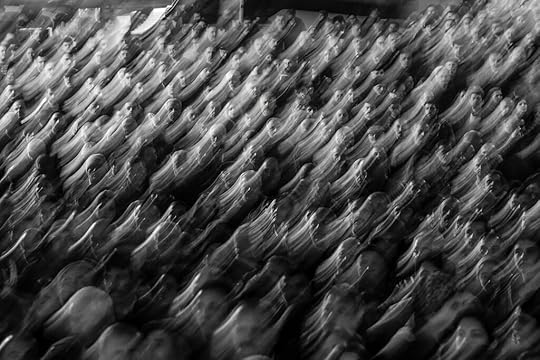 Cansu Yıldıran, from The Dispossessed, 2016
Cansu Yıldıran, from The Dispossessed, 2016As Yıldıran frequented Çaykara in the mid-2010s, social protests were rocking Turkey and testing the patience of its authoritarian leader, Recep Tayyip Erdoğan. Yıldıran skipped class to join protests at Cerattepe, where thousands marched against planned mining activities by cronies of Erdoğan; eventually, because they were failing her coursework, they left college. Women led the charge in these protests against mining: blowing whistles, playing accordions and drums, banging pots and pans. They inspired Yıldıran to spend a month in 2015 tracking, climbing mountains, and photographing local activists, with an eye to “preserve these things and to act as their memory,” they said. “To help me recall how they felt like at the time.”
In 2016, Yıldıran won a photography contest, Foto Istanbul. The winning image shows Burçak, a trans woman walking down a street. Her back naked and straight, she stands tall against several people, primarily men, who consider her from a judging distance. Taken during Trans Pride in Istanbul, Yıldıran’s photograph, part of their Shelter series, distills the Turkish government’s intensifying assault on queer communities, known locally as lubunyalar. As efforts to marginalize and criminalize lubunyalar increased, Yıldıran’s interest in documenting the “self-exploration” of Generation Y grew: One man places his head on another’s naked body, where he takes refuge. Shaving each other’s heads, sharing lights for cigarettes, cruising, and dancing, Istanbul’s lubunyalar opened their bodies and hearts to the photographer. Yıldıran shared those images on Instagram, where they had seventeen thousand followers. Then, in 2022, Instagram closed the account. “It was because of the nudes,” said Yıldıran. “That day I learned not to trust Instagram.” Now, they are focused on maintaining an archive and not relying on social media.
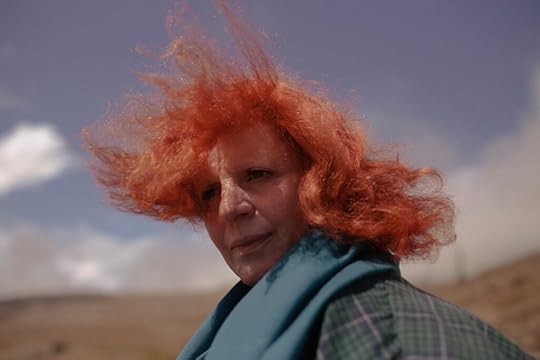 Cansu Yıldıran, from The Dispossessed, 2019
Cansu Yıldıran, from The Dispossessed, 2019For years Yıldıran mainly used a Canon AE-1 and shot their projects on 35mm film. Pressing the shutter once, instead of fifty times, felt right, and they savored “this serenity of waiting for the right image.” The technique empowered hallucinatory frames where characters seem unaware of being filmed but also act out. One example is Yıldıran’s work on Eleni Çavuş, a rifle-wielding Pontic guerrilla, who spent a year in the Nebiyan mountains in Samsun in 1924, before Turkish soldiers captured her in a cave there. Yıldıran’s mother Ayşe Durgun played the role of Eleni. According to legend, a Turkish sergeant had killed Eleni’s child, so she killed him, wore his jacket and gun, and climbed the mountain, from whence her dead body returned. “What happened to the Pontus people is rarely talked about. It’s a really dark history,” said Yıldıran. “It’s not part of the public conversation, and that pisses me off.”
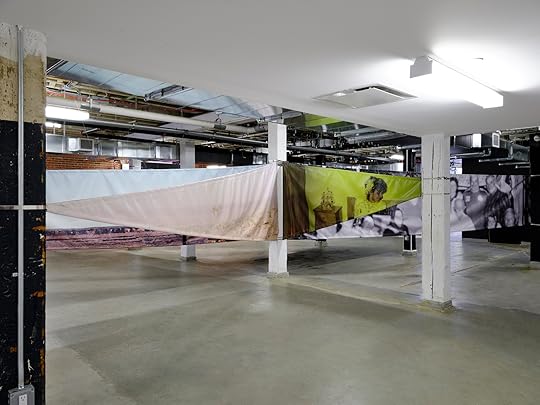 Installation views of Cansu Yıldıran: Haunt the Present, the Arts Center at Governors Island, New York, 2024. Photographs by Yi Hsuan Lai
Installation views of Cansu Yıldıran: Haunt the Present, the Arts Center at Governors Island, New York, 2024. Photographs by Yi Hsuan LaiCourtesy Protocinema and Lower Manhattan Cultural Council
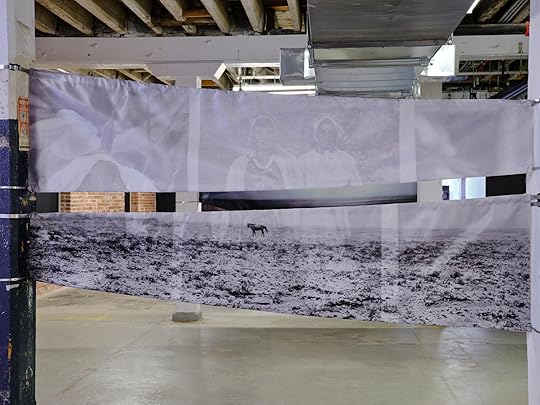
Haunt the Present, Yıldıran’s first exhibition in the US—recently presented at the Arts Center at Governors Island in New York—riffs on previous series, adding new layers. The photographic-sculptural installation tells a semifictional immigration story, imagining a scenario in which Yıldıran’s mother immigrates to the US from the Black Sea. The show includes images of both places, and for the images of America, Yıldıran spent weeks road-tripping from Michigan to the Pacific Ocean, driving up to ten hours daily, visiting national parks. Istanbul’s lubunyalar were an inspiration: Yıldıran observed how they began immigrating outside Turkey in large volumes over the past decade. “I felt oppressed in Istanbul, and to get away and see all the vast vistas opened me up.” The superimposed images explore the possibility of meshing the Anatolian plateau and the American landscapes and ask whether they can converse.
The intermingled fragments of Yıldıran’s vision will endure: the faces of their mother and aunt in costume, details from historic Pontus photographs, and images of Black Sea women who continue to live under the oppression of a patriarchal regime. Their multilayered compositions create new geographies. “This is why I add volume, cut, and shape my images,” they said. “I build my dreamlands.”
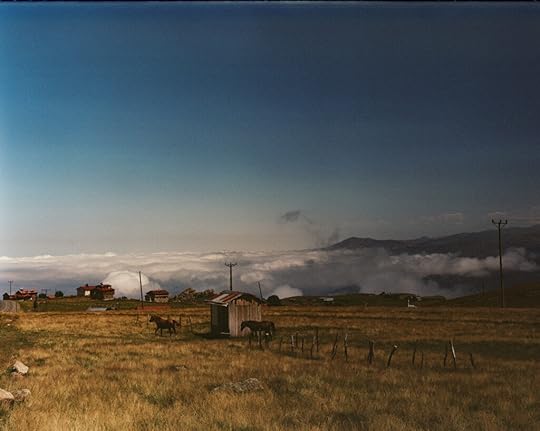 Cansu Yıldıran, from The Dispossessed, 2023
Cansu Yıldıran, from The Dispossessed, 2023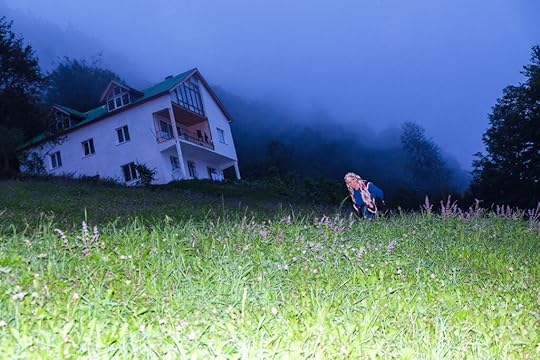 Cansu Yıldıran, from The Dispossessed, 2016
Cansu Yıldıran, from The Dispossessed, 2016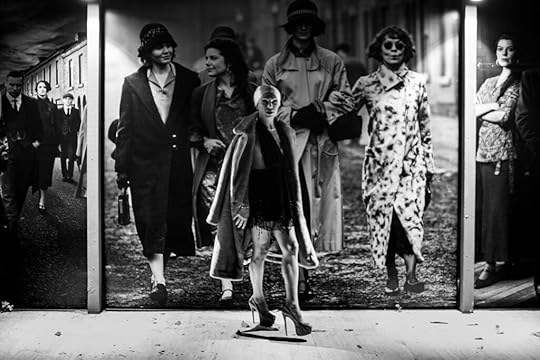 Cansu Yıldıran, from The Shelter, 2022
Cansu Yıldıran, from The Shelter, 2022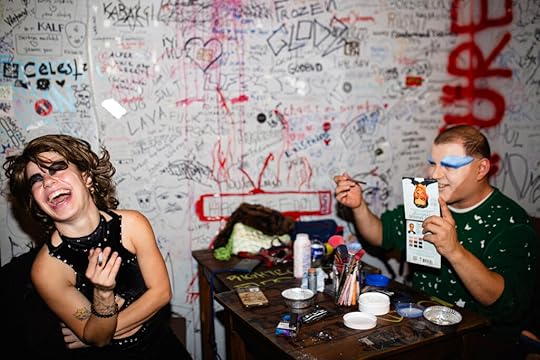 Cansu Yıldıran, Ahsen and AkışKa, 2022, from The Shelter
Cansu Yıldıran, Ahsen and AkışKa, 2022, from The Shelter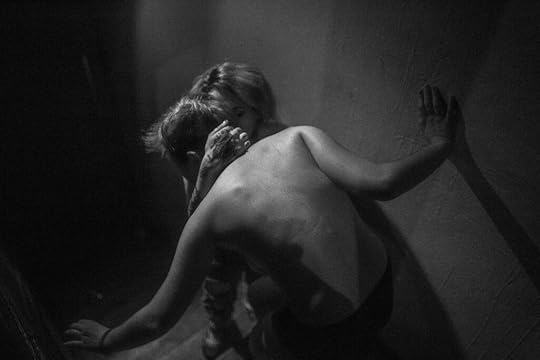 Cansu Yıldıran, from The Shelter, 2017
Cansu Yıldıran, from The Shelter, 2017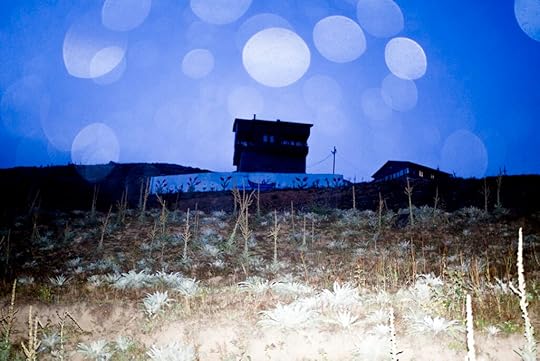 Cansu Yıldıran, from The Dispossessed, 2017
Cansu Yıldıran, from The Dispossessed, 2017 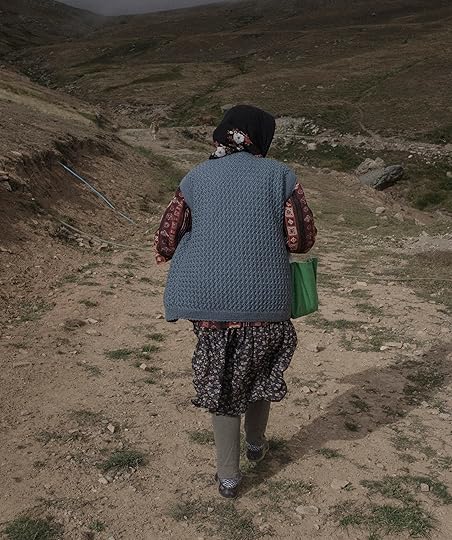 Cansu Yıldıran, from The Dispossessed, 2018
Cansu Yıldıran, from The Dispossessed, 2018 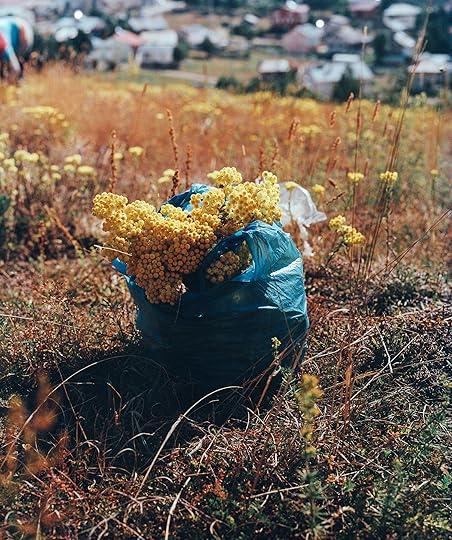 Cansu Yıldıran, from The Dispossessed, 2023
Cansu Yıldıran, from The Dispossessed, 2023 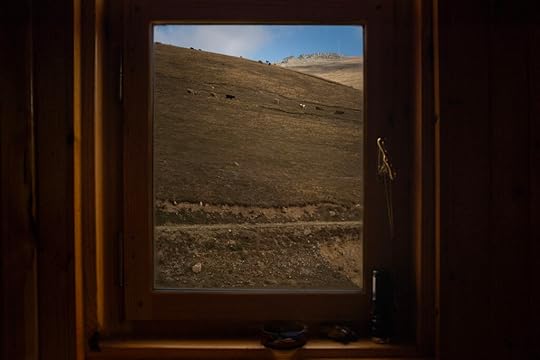 Cansu Yıldıran, from The Dispossessed, 2017
Cansu Yıldıran, from The Dispossessed, 2017All photographs courtesy the artist
Read more from our series “Introducing,” which highlights exciting new voices in photography.
December 5, 2024
Trevor Paglen on Artificial Intelligence, UFOs, and Mind Control
Long before the torrent of attention unleashed by ChatGPT’s public release in November 2022, the artist Trevor Paglen was patiently teaching us about the underlying technologies and training sets of artificial intelligence. He not only demonstrated how they interpret images—rendering them into data whose applications have severe social and moral consequences—but also unveiled what they are made of. Paglen’s art is about surveillance, technology, and hidden forms of power. But one could also say his work is about faith and doubt: It bolsters our faith that certain things we can’t see really do exist, and sows doubt about whether we consented to live in a society where certain things exist. CIA black sites and rendition programs. Spy satellites. Secret military bases. Machine-hallucinated images. Racist classification schemes fueling facial recognition systems. The surveillance of our everyday behaviors. UFOs.
Paglen deploys the camera less for depictive purposes than as an analogy for the extraordinary labor of making something visible—whether the thing to be seen is a surveillance drone, the computational analysis routinely performed on photographs of our faces, or a strategy of psychological warfare shaping our media consumption. Photography is neither his sole medium nor his raison d’être, but it’s indispensable to a practice that examines how belief is compelled.
 Trevor Paglen, Tornado (Corpus: Spheres of Hell) Adversarially Evolved Hallucination, 2017
Trevor Paglen, Tornado (Corpus: Spheres of Hell) Adversarially Evolved Hallucination, 2017Sarah M. Miller: You’ve interrogated the history, tools, and implications of AI for about twelve years, focusing particularly on systems that interpret images. How does it feel that the rest of the world is catching up to this topic—and is it too late?
Trevor Paglen: It’s not too late. I’m happy that the rest of the world is catching up, because it’s important to have other voices in these conversations. For a very long time, these conversations have been happening in computer science departments, in tech companies, and I think a lot of people from the humanities didn’t even know that there was this whole other mode of vision—seeing with machines—being developed and becoming a part of our everyday infrastructures. The theory of perception underlying so much of AI and computer vision is shockingly bad from a humanities perspective. It’s crucial for people with backgrounds outside the tech industry to look at these systems critically.
Miller: You often use the terms “computer vision” or “machine learning”—as opposed to “artificial intelligence”—to describe the subject of your research. What’s the difference?
Paglen: Computer vision has a long history, going back to the 1950s and ’60s, that overlaps with the development of digital photography, digital imaging, image processing, et cetera. And there are a bunch of pre–machine learning algorithms that are still in common use in computer vision. I generally try to use “computer vision” because I’m bracketing out stuff about language, and chatbots, and other kinds of optimization algorithms that fall under AI more generally.
The machine learning moment really starts around 2012, and it’s when people figure out that you can use neural networks, which had been invented a long time ago, to actually do stuff—as long as you have a whole bunch of training data and a whole bunch of computing power. Machine learning is the stuff that what we now call AI is made out of. But there have been different approaches to AI in the past that had nothing to do with machine learning at all—the dominance of the machine learning approach is relatively new, whereas AI has been around for a long time.
“Artificial intelligence” also doesn’t really mean anything, and it has a lot of ideological associations. It’s a term that lends itself to mystification.

Trevor Paglen, Image Operations. Op. 10, 2018. Single channel video projection, sound, 23 minutes
var container = ''; jQuery('#fl-main-content').find('.fl-row').each(function () { if (jQuery(this).find('.gutenberg-full-width-image-container').length) { container = jQuery(this); } }); if (container.length) { const fullWidthImageContainer = jQuery('.gutenberg-full-width-image-container'); const fullWidthImage = jQuery('.gutenberg-full-width-image img'); const watchFullWidthImage = _.throttle(function() { const containerWidth = Math.abs(jQuery(container).css('width').replace('px', '')); const containerPaddingLeft = Math.abs(jQuery(container).css('padding-left').replace('px', '')); const bodyWidth = Math.abs(jQuery('body').css('width').replace('px', '')); const marginLeft = ((bodyWidth - containerWidth) / 2) + containerPaddingLeft; jQuery(fullWidthImageContainer).css('position', 'relative'); jQuery(fullWidthImageContainer).css('marginLeft', -marginLeft + 'px'); jQuery(fullWidthImageContainer).css('width', bodyWidth + 'px'); jQuery(fullWidthImage).css('width', bodyWidth + 'px'); }, 100); jQuery(window).on('load resize', function() { watchFullWidthImage(); }); const observer = new MutationObserver(function(mutationsList, observer) { for(var mutation of mutationsList) { if (mutation.type == 'childList') { watchFullWidthImage();//necessary because images dont load all at once } } }); const observerConfig = { childList: true, subtree: true }; observer.observe(document, observerConfig); }Miller: A lot of your work related to AI functions as tutorial—teaching viewers how computer vision works and what it’s built on. One of my favorites is Image Operations. Op. 10 (2018). Could you describe how you made that piece?
Paglen: It’s a video of musicians performing Debussy’s String Quartet in G minor, Op. 10. You’re watching the string quartet playing, you’re hearing the music, and your visual perspective gradually shifts from that of a camera to that of various computer vision and AI algorithms, which are interpreting the performers and their actions—the machinic eyes of algorithms that are designed to estimate age, gender, ethnicity, emotional states, gestures. So you’re getting a sense of the different ways that humans have developed to try to have computers make sense of images.
We built a programming language in my studio to work with computer vision tools, and to turn their algorithmic abstractions back into images. I looked at different kinds of media and images to find the thing that I felt contrasted most with the machinic ways of seeing. Instrumental music performance—that’s almost pure affective excess, fundamentally not quantifiable. So that’s the juxtaposition I set up in that piece.
Miller: It’s amazing to watch the analytics take place in real time. It makes you understand that the calculations about who these people are, what they’re doing and expressing, are constantly changing and often confounding. If these algorithms were being applied in a situation like analyzing surveillance footage, they’d be unreliable and—at least sometimes—totally out of sync with what a human would be perceiving.
Paglen: I also made a series of images of clouds. You’re seeing the cloud in a photograph I made, but you’re also seeing the cloud as it’s being seen through computer vision algorithms—including some used by drone and missile systems, facial recognition systems, and self-driving cars. It’s kind of a contemporary take on Stieglitz’s photographs of clouds. When you think about computer vision, what it’s essentially doing is taking an image, or some kind of visual sensory input, and creating a mathematical abstraction out of it.
Miller: A critic writing for Forbes, Jonathon Keats, said that you are to artificial intelligence “what Upton Sinclair was to meatpacking.” It’s a great comparison.
Paglen: Well, that’s a very high compliment, because it took me a long time to develop an understanding of how these tools work, and a feeling for it, and then to find language to talk about it. It’s a different paradigm, a fundamentally different way of thinking about images than I was taught in art school.
 Trevor Paglen, ImageNet Roulette (detail), 2019
Trevor Paglen, ImageNet Roulette (detail), 2019Miller: Your work on training sets has exposed the perils of simplistic image labeling that equates picture with thing, type, or identity. ImageNet Roulette (2019), for example, demonstrates that the prevailing attitudes underlying our foundational facial image recognition tools are equal parts absurd, crass, stereotypical, racist, and misogynist, not to mention culturally and historically bound.
Paglen: ImageNet is the most widely used dataset in computer vision research, created between 2009 and 2011. The people who created it said they wanted to make a database of “the entire world of objects.” So how do you do that? They took WordNet, a specific kind of dictionary where synonyms are clustered according to concept, in a hierarchical structure, under high-level categories like plant, person, and artifact. They only kept the nouns; the theory was that a noun is an object you can take a picture of. Each synonym became a slot. Then they scraped the whole internet, pulling in as many images as they could, and hired clickworkers to organize those images into the slots. In other words, the process required workers to decide what each image meant, and label it from a pre-given classification scheme.
It was kind of quaint, in retrospect. They were thinking, It’s so big, who could possibly ever look at the whole thing? Well, you can look at twenty thousand words, and the images to which they’ve been correlated, in an afternoon. The fundamental approach is terrible. There are tons of misogynistic nouns, tons of racist nouns, cruel nouns—nouns that are at once abstract and terrible. There are also plenty of nouns that aren’t visual at all.
When projects like ImageNet Roulette came out, and other people started looking at these datasets and realizing how terrible they were, the industry response was: “Let’s just remove anything that could be controversial.” There was no fundamental rethinking of the architecture, or of that relationship between images and concepts.
 Aperture Magazine Subscription 0.00 Get a full year of Aperture—the essential source for photography since 1952. Subscribe today and save 25% off the cover price.
[image error]
[image error]
Aperture Magazine Subscription 0.00 Get a full year of Aperture—the essential source for photography since 1952. Subscribe today and save 25% off the cover price.
[image error]
[image error] 
In stock
Aperture Magazine Subscription $ 0.00 –1+ View cart DescriptionSubscribe now and get the collectible print edition and the digital edition four times a year, plus unlimited access to Aperture’s online archive.
Miller: In an article coauthored with Kate Crawford, you wrote: “Images are remarkably slippery things, laden with multiple potential meanings, irresolvable questions, and contradictions. Entire subfields of philosophy, art history, and media theory are dedicated to teasing out all the nuances of the unstable relationship between images and meanings.” And yet here we are: subject to vastly powerful systems built by people who never seem to question the relationship between representation and reality, pictures and meaning.
Paglen: Where these correspondences are most obviously “useful” is in industrial processes and in policing. Computer vision systems built to monitor truck drivers are a good example. Right now, you’re seeing the truck drivers as the canaries in coal mines, in terms of what the future AI-assisted labor surveillance looks like. The company that owns the truck will install a smart camera in the truck that watches the driver, and if—according to an algorithm—the driver is smoking a cigarette, or eating, or takes their eyes off the road, or looks drowsy, they’ll get pinged. They’ll get fined, or their supervisors will be contacted. So there’s an automation of surveillance of this kind of labor.
You’re seeing something similar emerge now in normal cars, where insurance companies want data about how you’re driving, and to modulate your insurance premiums in real time based on how a computer vision system is evaluating your driving. Philosophically and morally, there are huge problems with this way of thinking about images. But if you want to extract value from a domestic or previously private space, these tools are very good at doing that.
“Artificial intelligence” doesn’t really mean anything. It’s a term that lends itself to mystification.
Miller: I think you’re saying that the work of extracting value from labeled images via artificial intelligence gets more sophisticated—but the approach to images themselves is not getting any more nuanced.
Paglen: I want to say something more precise, which is that literalness and the economics of extraction go hand in hand. If a company wants to extract value by putting a computer vision system in your kitchen to watch what you eat, what they don’t want to do is say, “Oh, the meaning of that food is variable . . . it’s all contextual, it’s relational.” What they want to be able to say is, “You ate the doughnut, your health insurance is going to go up.” So the quantification is part of the process of value extraction. The quantification of an image is where I think we agree there’s a massive philosophical problem, as well as a human rights problem. But that moment of quantification is the precondition for being able to extract value. These very rigid ways of seeing are a feature of the system, not a bug.
Miller: You regularly talk to people who work in AI, and specifically in the area of training sets for machine learning. What do they say when you raise the idea that images don’t have transparent, consistent meanings?
Paglen: It’s very rare, I’ve found, among people who come from an engineering background, or mathematics or computer science, to be able to conceptualize the world in a way that does not reduce it to computation. I have yet to have a nuanced discussion with somebody coming out of that technical background who is able to really engage with the idea that there is a deep, irresolvable philosophical problem here—one that is not just a thought experiment but that has genuine and often deadly consequences for real life.
 Trevor Paglen, They Took the Faces from the Accused and the Dead … (SD18), 2020. Mug shots of accused criminals and incarcerated people served as a common source for facial recognition algorithms in the early 1990s.
Trevor Paglen, They Took the Faces from the Accused and the Dead … (SD18), 2020. Mug shots of accused criminals and incarcerated people served as a common source for facial recognition algorithms in the early 1990s.  Trevor Paglen, They Took the Faces from the Accused and the Dead . . . (#00638_1_F), 2019
Trevor Paglen, They Took the Faces from the Accused and the Dead . . . (#00638_1_F), 2019 Miller: Your work is dedicated, in large part, to exposing the infrastructures of analytical and predictive systems that we can’t see. Do you think that the recent shift in popular attention to generative AI—this widely available power to order up an image, or generate text—is a distraction from the underlying technologies? Or does it inspire you to pursue a new set of questions?
Paglen: The work I’ve done in response to the generative turn doesn’t use AI machine vision at all. I’m thinking about the history and practice of the manipulation of perception, in relation to media that’s increasingly self-optimized to produce a specific response in an individual—to make them believe something that you want them to believe, to make them perceive something that you want them to perceive, or to make them do what you want them to do.
I’m looking at things like CIA mind-control experiments, stage magic, military psychological operations. These are all examples of some kind of authority using techniques that take advantage of the quirks in your perception, in order to make you perceive the world in a particular way. That is not only what generative AI is doing under the hood, so to speak, but where I think it will go culturally.
Miller: What accounts for your shift in approach? Much of the work you did about computer vision was openly didactic, whereas the more recent work on psyops and mind control seems more oblique.
Paglen: I think about my history as an artist as characterized by different ways of looking at technology. One mode is looking at infrastructure: Let’s go look at data centers, undersea cables, spy satellites in the sky. Let’s see all the stuff around us that is part of planetary computation systems, or surveillance systems, or sensing systems. In mode two, I’m looking at things that are also looking at me. How do these machines see? That encompasses computer vision, AI, that sort of thing.
I think the third phase I’m heading into now is: How are they currently able to make us see things, and images, that we didn’t see before? What are the politics of that? In other words, how did these technologies that are able to see us create the possibility of a media landscape in which not only are we being surveilled, but that surveillance is being used to create new kinds of visual culture for humans, in order to extract value from us?
Advertisement
googletag.cmd.push(function () {
googletag.display('div-gpt-ad-1343857479665-0');
});
Miller: Could you describe one of the newer works that addresses the media you’re describing—media that is tailored to make us see, or react to, or believe something?
Paglen: One of the central works so far is a video installation of a guy talking, Doty (2023). The guy is Richard Doty, who did psyops for the Air Force in the 1970s and 1980s. He talks about the technique and the trainings: “This is how you conduct influence operations.” “These are the elements that you need to make a good one.” He’s breaking down how you do it. Then he talks about influence operations that he ran against different people, mostly using UFOs as a kind of mimetic device to get people to see things or to believe things that he wanted them to believe. But then, there’s also a flip in the film, where he says, “Yes, I created a ton of disinformation and ran a bunch of psyops using the UFO as a mimetic device. But also, UFOs are real. And I’m going to tell you about them now.”
I find this guy’s tactics a, for lack of a better word, mind fuck. I also think it points to an emerging media environment where the distinction between reality and unreality, or between hallucination and fidelity, is irrelevant.
I have a new project of UFO photography, which is something I’ve always been super interested in. I often think about UFO photography as the paradigm of photography. Something like, all photos are UFO photos. It’s very much in line with the recent work on psyops.
 Trevor Paglen, Near Windy Hill (undated), 2024
Trevor Paglen, Near Windy Hill (undated), 2024  Trevor Paglen, UNKNOWN #89161 (Unclassified object near The Revenant of the Swan), 2023
Trevor Paglen, UNKNOWN #89161 (Unclassified object near The Revenant of the Swan), 2023All images courtesy the artist; Altman Siegel, San Francisco; and Pace Gallery
Miller: Photography historians like me, of course, love to point out that it’s always been possible to manipulate or stage or alter an image to present a deceptive or partisan view of reality. But with generative AI, we’re way beyond Stalin removing his political rivals from official photographs, both in terms of reach and potential consequences. How do you think we might deal with the problem of propagandistic deep fakes, for example, without reinforcing the notion that a real photograph is, or ever was, a necessarily truthful witness?
Paglen: As people who think about photographs, we know that they’re staged, they’re decontextualized, et cetera. However, I think that both of us would say it is a good thing that we got the images from Abu Ghraib, for example, in the sense that they did political work. Or at least, they prompted discussion by making something visible. Even though photographs don’t tell the Truth, they have a kind of aesthetics of truth that can take you pretty far in terms of putting things on a cultural agenda.
AI breaks the idea that somebody took the picture. I worry that even though we’re suspicious of concepts like indexicality, they still do cultural work in terms of how we read photographs collectively. When that breaks, I don’t know what happens. It does break a shared reality, which didn’t exist in the first place, that was always manufactured. That’s a depressing question to have to ask: Is manufacturing consent the precondition of a certain kind of democracy?
Miller: Is this the end of photography as we knew it then?
Paglen: Well, I think how we understand photography is more important than ever. People who study photographs or make photographs or work with photographs are highly relevant to a world in which everything is photography. I think about self-driving cars as photography and spy satellites and drones as photography. I think about any facial recognition system as photography. Photography is the paradigm of human-technology interfaces, and at this point, it’s basically synonymous with a huge amount of the infrastructure we interact with. People who think critically about photographs have a great deal to contribute, in terms of trying to conceive of and implement the kind of world that we want to live in, because the world is increasingly hard to distinguish from photography.
This article originally appeared in Aperture No. 257, “Image Worlds to Come: Photography & AI.”
November 22, 2024
How Can Photography Shape our Relationship to the Environment?
Edra Soto’s El Destino (Destination) (2024)—a wall-sized structure installed in the Carnegie Museum of Art, Pittsburgh—is filled with snapshots of San Juan, Puerto Rico: bright bougainvillea, neighborhood street views, a house glimpsed through a hole in a fence. Except, you wouldn’t know it. The images can only be accessed by bending down to peer through the little holes in the structure, as you would look through the viewfinders or keyholes of a different time. It’s a piece that sets the tone for Widening the Lens: Photography, Ecology, and the Contemporary Landscape, an exhibition that proposes expansive and multidimensional responses to human-environmental relationships as mediated through photography. The nineteen artists in the exhibition engage with land and place through the sensorial and the political, proposing possible answers to scholar Eva Díaz’s question, “How can we overturn the historical bias of experiencing site primarily through vision?”
 Edra Soto, El Destino (Destination), 2024. Paint, sintra, aluminum, viewfinders, inkjet prints
Edra Soto, El Destino (Destination), 2024. Paint, sintra, aluminum, viewfinders, inkjet prints David Hartt, The Histories (Crépuscule), 2021. Single-channel 4K video, color, sound, radio, tapestry. Installation views in Widening the Lens: Photography, Ecology, and the Contemporary Landscape, Carnegie Museum of Art, Pittsburgh, 2024
David Hartt, The Histories (Crépuscule), 2021. Single-channel 4K video, color, sound, radio, tapestry. Installation views in Widening the Lens: Photography, Ecology, and the Contemporary Landscape, Carnegie Museum of Art, Pittsburgh, 2024Photographs by Zachary Riggleman
Near El Destino, David Hartt’s The Histories (Crépuscule) (2021) presents a fabricated experience of the sublime. A broad, woven vista of the Jamaican coastline recalls nineteenth-century paintings, while a blue-hued video of icebergs conjures a sense of impending doom. Graphically rendered palm trees on the far side of the tapestry situate the viewer in the tropics. All is set to lo-fi electronic music. The effect of peering at Soto’s small pictures fosters curiosity at the same time that it negates and obfuscates the type of broad views that Hartt’s work references and re-presents, offering two alternatives to, and critiques of, the visual language of colonial landscapes that has long characterized views of Latin America and other Global South territories. In contrast to Hartt’s monumental images, only one person at a time can see a particular view in Soto’s structure; landscape is construed as a slow, private experience.
 Chanell Stone, Silt, 2022
Chanell Stone, Silt, 2022Courtesy the artist
 Chanell Stone, River Wading, 2022
Chanell Stone, River Wading, 2022 Widening the Lens succeeds in foregrounding realms beyond the visual and in centering artists who address fraught histories of slavery and forced labor, indigenous dispossession, and ongoing structural inequity and exclusion inscribed in landscape. They contend directly with the imperial origins of photography, as per theorist Ariella Azoulay. Through performative gestures, Xaviera Simmons, Dionne Lee, and Chanell Stone present various photographic approaches for grappling with the history of landscape in relation to the Black female body. In her Sundown series (2018–23), Simmons appears in brightly patterned clothing, holding up objects that refer to the history of Sundown towns, municipalities or neighborhoods that excluded Black people after sunset, a widespread form of Jim Crow–era discrimination. In Sundown (Number Two) (2018), the artist wears a purple patterned dress and stands with her back to the camera, facing a dense, green hedge. She holds across her back a photograph of a group of Black agriculture laborers and white overseers, all leaning against the back of a truck. These are sharecroppers, not enslaved workers, but the photograph still makes explicit a racial hierarchy that descends from chattel slavery.
The connection between Black bodies and the land is also front and center in Dionne Lee’s poetic photographs, which reflect on strategies and skills for wilderness survival and on the construction of the outdoors as intended for white leisure. Lee’s images of tender gestures also reflect on the medium-specificity of photography: Breaking the Fall (2016) closely frames the artist’s brown hands as they move across a color photograph of natural vegetation, tearing into it, as if making room for darkness and absent histories.
 Victoria Sambunaris, Untitled (jump), Glamis, CA, 2020
Victoria Sambunaris, Untitled (jump), Glamis, CA, 2020Courtesy the artist and Yancey Richardson Gallery, New York
 Justine Kurland, Broadway (Joy), 2001
Justine Kurland, Broadway (Joy), 2001Courtesy the artist
Stone’s dark, large self-portraits in agricultural fields allude to the perils of the outdoors that Black individuals and Maroon communities faced; other pictures focus on the place of Black bodies in urban, public spaces. With their somber, silvery hues, Stone’s photographs recall the deep darkness of Dawoud Bey’s and Roy DeCarava’s photographs, but frame an emphatically female gaze and presence in the landscape. The outdoors as a place for women and queer individuals is also foregrounded in Justine Kurland’s joyous Girls series (1997–2002), and in more somber, striking tones in Mark Armijo’s McKnight’s high-contrast, black-and-white series Hunger for the Absolute, which depicts queer male bodies languorously embedded within the Southern California desert. Sam Contis’s delicate black-and-white views of walls and fences in the British countryside, from the series Overpass (2020–22), home in on the modifications that render them porous and traversable, while veteran landscape photographer Victoria Sambunaris’s expansive views of sand dunes reveal the dirt bikers in their midst only to those who step up close.
 David Alekhuogie, Borrowed Recipe 1, 2021
David Alekhuogie, Borrowed Recipe 1, 2021Courtesy the artist and Yancey Richardson Gallery, New York
 Dionne Lee, A Plot that Also Grounds, 2016
Dionne Lee, A Plot that Also Grounds, 2016Courtesy the artist
The experience of the works in the second gallery is mediated by the mournful songs in Diné artist Raven Chacon’s Three Songs (2021), an affecting video of three indigenous women singing at historic massacre or displacement sites, accompanied by the rhythmic beating of a drum. Their voices activate Ho-Chunk artist Sky Hopinka’s delicate photographs of waters, skies, and forests, to which he applies delicate, meandering cursive writing. His phrases appear like lichen growing on the captured forms, making no distinction between human and non-human organisms. They reflect lyrically on long histories of togetherness, rather than separation between people and land, as do David O. Alekhuogie’s vivid and layered color photographs, with their attention to place, to food traditions, and Black history in works such as the collage Borrowed Recipe 1 (2021).
 Melissa Catanese, Fever field (California poppies, hands, seabirds, sun), 2021, 2023
Melissa Catanese, Fever field (California poppies, hands, seabirds, sun), 2021, 2023Nearby, Fever field (California poppies, hands, seabirds, sun), 2021 (2023), a wall-sized ethereal installation by Melissa Catanese, invites a multisensorial experience of beauty commingled with grief. The work features soft-focus color photographs of bright orange poppies in bloom alongside black-and-white fragments of found photographs. Printed on vellum, the pictures sway with the gentle air currents in the gallery. Approaching multidimensionality from a different angle, Erin Jane Nelson’s compellingly strange ceramics and a quiltlike fabric works, which contain embedded photographs of plant life, point at the sculptural possibilities of engaging photography with other physical media. They do not so much straddle as triumphantly override the tired dichotomy between craft and art.
 Sky Hopinka, Cowboy Mouth 2 (Yoiréreginagere), 2022
Sky Hopinka, Cowboy Mouth 2 (Yoiréreginagere), 2022Courtesy the artist
Ecological devastation and the uncertain future of sustainable human life on the planet are especially in focus in the last two galleries. Cyprien Gaillard’s video Ocean II Ocean (2019) includes dreamy underwater footage that reveals the surprising afterlife of New York subway cars dumped into the ocean, and the turtles and fish that are now its passengers. Fazal Sheikh’s documentary and aerial photographs of radioactive waste sites in Navajo territory in Utah are a sobering reminder of newer forms of dispossession and climate despoliation, and the ways environmental racism ruinously affects the lives and health of indigenous communities. The timed explosions of Lucy Raven’s video installation Demolition of a Wall (Album 2) (2022) punctuate the experience of the second half of the exhibition with a sense of eerie discomfort that echoes through the sparser installation of the third and fourth rooms, with the latter also showcasing Raven’s mysterious shadowgrams, moving the experience of landscape in this exhibition into its most abstracted presentation.
 Fazal Sheikh, 37°8’0.88″N/109°52’28″W, Mexican Hat Uranium Mill Disposal Cell, Mexican Hat, Utah, 2017
Fazal Sheikh, 37°8’0.88″N/109°52’28″W, Mexican Hat Uranium Mill Disposal Cell, Mexican Hat, Utah, 2017Courtesy the artist
Widening the Lens is a fitting title for a curatorial project that presents an expansive way to conceive of landscapes and human-environmental relations, while also leaving the visitor with a lingering sense of disquiet. The opportunity to see an installation or multiple works by most artists in the show allows for deeper engagement with the pieces’ multiple meanings as well as the conversations between them. The show foregrounds multiplicity, echoing scholar W. J. T. Mitchell’s definition of landscape as a “physical and multisensory medium (earth, stone, vegetation, water, sky, sound and silence, light and darkness, etc.).” At the same time, it lends credence to T.J. Demos’s sobering reminder that “photography doesn’t just show the effects of the Anthropocene, it also helps produce it.”
Widening the Lens is on view at the Carnegie Museum of Art in Pittsburgh through January 12, 2025.
Roï Saade Is Building a New Photobook World
In 2022, the Lebanese-born photographer and designer Roï Saade founded Bound Narratives, a roving archive, workshop, and exhibition program conceived to promote photobooks by Middle Eastern and North African artists. Packing his library into several suitcases, Saade has brought Bound Narratives to Beirut, Florence, Montreal, and Sarajevo, and plans to soon take it to Tunis and Egypt. Here, he discusses the struggle against Eurocentric publishing norms, his process-driven approach, and how photobooks can redraw lines of belonging.
 Spread from Abdo Shanan, Dry (self-published, 2022)
Spread from Abdo Shanan, Dry (self-published, 2022)Dalia Al-Dujaili: Tell me about your journey into bookmaking, curation, and design.
Roï Saade: After a few years in the corporate world, I felt the need to get out of it and work toward something more creatively fulfilling. While studying graphic design at USEK University, in Lebanon, I had taken some photography courses. I found that photography was a means to access communities that I don’t belong to, to break these religious and social barriers and just explore Beirut.
And photobooks allowed me to work at the intersection of design and photography. As an editor, I want to recognize work that is not being acknowledged by the industry’s gatekeepers, and to counter stereotypical depictions of West Asia and the Arab world. My practice is very research-driven and relies on close collaboration with other artists. I’m attracted to the process rather than the end result.
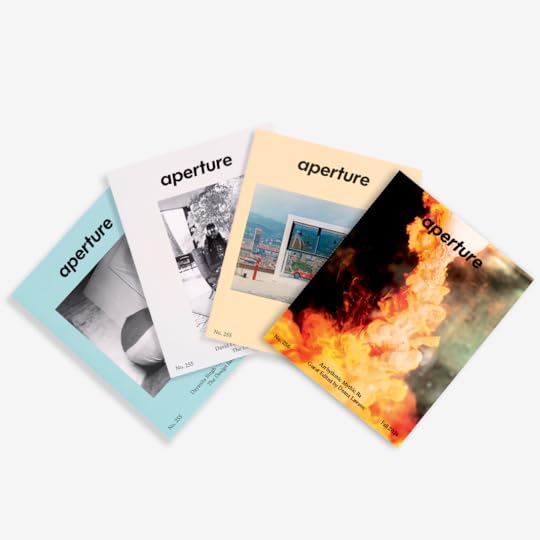 Aperture Magazine Subscription 0.00 Get a full year of Aperture—the essential source for photography since 1952. Subscribe today and save 25% off the cover price.
[image error]
[image error]
Aperture Magazine Subscription 0.00 Get a full year of Aperture—the essential source for photography since 1952. Subscribe today and save 25% off the cover price.
[image error]
[image error] 
In stock
Aperture Magazine Subscription $ 0.00 –1+ View cart DescriptionSubscribe now and get the collectible print edition and the digital edition four times a year, plus unlimited access to Aperture’s online archive.
Al-Dujaili: Can you tell me about the motivations behind Bound Narratives?
Saade: Bound Narratives is a growing archive of photobooks from and about the MENA [Middle East and North Africa] region. It strives to build a broad and open repository of visual materials to stimulate education and critical discourse through photography and digital narrative. In doing so, the archive seeks to remedy an imbalance of cultural knowledge between the Global South and North. The MENA region is very familiar with the American and Eurocentric canon of photography. Our bookstores, libraries, and homes are filled with Western photobooks. Yet it’s rare to find photobooks from the region itself in these collections. It was first an internal critique.
We have no shortage of artists or storytellers. In fact, it’s the opposite. We have an overwhelming amount. It is the economic and political realities—and the lack of resources and publishers—that disconnect us from each other and from the world. We depend heavily on the West to acknowledge us first and publish our work. And that’s why my initiative is to try to create exposure, however minimal it is. Whatever the problems are, try to solve some of them yourself. So, I started a public inventory and started asking my network of artists to share photobooks by artists in the region.
 Bound Narratives at Takeover, an artist-led project space in Beirut, April 2023
Bound Narratives at Takeover, an artist-led project space in Beirut, April 2023Al-Dujaili: I’m wondering what the challenges are. I know you live and work in Canada, but you also do work in Lebanon and in the region as well.
Saade: Yeah, I work and live between Lebanon and Canada. The challenges are economic, no doubt. We can’t underestimate how the lack of resources and money control what is being seen and how it’s being seen. Most of the artists I collaborated with are self-published. Everyone is struggling, fighting for crumbs from Western institutions. And so, you have to try to be creative. You’re very limited, and in these limitations, you have to dance and find ways. By contrast, when foreigners parachute to our region to work, they get easily published by someone in the West. It’s very interesting to see that struggle for locals to amplify their voices while foreigners are easily published. At the same time, you can also see a pattern where most of the published artists from the region get to be published in the West by either immigrating, or by living for a period of time or creating these networks in, let’s say, France or New York. When it’s not foreigners, it’s mostly diasporic artists who get wider visibility.
I’m interested in showing these books to local Middle Eastern and North African communities—for them to see what has been produced and what are these cultures around them that are so disconnected and so disrupted by regional politics. I also want to share them with the Global North to say: These narratives exist. There’s more than one modernity and contemporary. There are so many worlds in one world, and they can all fit together.
I see this project as helping to mitigate the construction of otherness.
Al-Dujaili: I love that, many worlds in one world.
Saade: With Bound Narratives, I focus on the book’s journey after its production. It’s a correspondence of the past and the present. It’s an exchange between the artist and the viewer. People sit on the carpets and focus on the book and consume it as a ritual. At Bound Narratives, you don’t have to buy a book. You can come to this gathering and look at the books and experience these books without the need of a financial transaction. What’s important is people being together, studying, playing together.

Cover and interior spread of Tamara Abdul Hadi’s Picture an Arab Man (We Are the Medium, 2022)
var container = ''; jQuery('#fl-main-content').find('.fl-row').each(function () { if (jQuery(this).find('.gutenberg-full-width-image-container').length) { container = jQuery(this); } }); if (container.length) { const fullWidthImageContainer = jQuery('.gutenberg-full-width-image-container'); const fullWidthImage = jQuery('.gutenberg-full-width-image img'); const watchFullWidthImage = _.throttle(function() { const containerWidth = Math.abs(jQuery(container).css('width').replace('px', '')); const containerPaddingLeft = Math.abs(jQuery(container).css('padding-left').replace('px', '')); const bodyWidth = Math.abs(jQuery('body').css('width').replace('px', '')); const marginLeft = ((bodyWidth - containerWidth) / 2) + containerPaddingLeft; jQuery(fullWidthImageContainer).css('position', 'relative'); jQuery(fullWidthImageContainer).css('marginLeft', -marginLeft + 'px'); jQuery(fullWidthImageContainer).css('width', bodyWidth + 'px'); jQuery(fullWidthImage).css('width', bodyWidth + 'px'); }, 100); jQuery(window).on('load resize', function() { watchFullWidthImage(); }); const observer = new MutationObserver(function(mutationsList, observer) { for(var mutation of mutationsList) { if (mutation.type == 'childList') { watchFullWidthImage();//necessary because images dont load all at once } } }); const observerConfig = { childList: true, subtree: true }; observer.observe(document, observerConfig); }Al-Dujaili: In 2022, you designed Tamara Abdul Hadi’s Picture an Arab Man.
Saade: Tamara’s book is an attempt to reframe the visual representation of contemporary Arab men. The design choices were informed by how she sees her father, how she sees her cousin, her nephew. So much of the effort was put into small, subtle details—the texture of the cover, the weight of the paper, the bouncing of reflective colors, the empty pages, the repetition of cropped images. I love this cover and the burgundy color of its endpaper. Her father is included. He was an amateur photographer, and she’s very inspired by him. The linen texture—how the image almost fades inside it—contributes to an ambiguity we were trying to communicate, as well as the softness and beauty that is very absent in mass-media representations of Arab men.
Al-Dujaili: That year, you also designed Dry, the second photobook by the Algerian photographer Abdo Shanan.
Saade: Abdo was very generous and trusting from the start, which is key to any collaboration. He gave me full access not only to his body of work but to his ideas, to his history. It’s about struggling to belong to a place that you feel doesn’t want you. I can relate to that in a way, given Algeria and Lebanon’s history of colonization. During the making of the book, I looked at the history behind these uprooted feelings to better understand the experience of postcolonial struggle. I read Frantz Fanon for the first time. I read The Wretched of the Earth (1961) and Black Skin, White Masks (1952), which informed my editorial and design decisions. Later, I read Colonial Trauma (2021) by Karima Lazali, which ended up being part of the book.
Advertisement
googletag.cmd.push(function () {
googletag.display('div-gpt-ad-1343857479665-0');
});
Al-Dujaili: That’s an insert in the book?
Saade: Yes. It’s a beautifully written insight into the psychopolitical effects of colonialism in Algeria. It fits very well in Dry because there are the personal stories and the collective reckoning with inherited trauma. Both Shanan, who is Algerian Black with mixed ethnic parentage, and the people he photographed are confronting their conflict with belonging. The book opens with a kind of descent. We see his window. Then, we go downstairs into a cemetery, and it’s silver ink on black paper. Then, his hand and his imaginative world. And then you start the book.
Al-Dujaili: You’ve named Samer Mohdad, the Lebanese Belgian photojournalist, visual artist, and writer, as an important influence.
Saade: Mohdad’s Mes Arabies was essential to my beginnings. It was a revelation seeing Arabs portrayed outside of an anthropological and orientalist framework. When I saw the work, I was just beginning photography. It was published in 1999. It’s one of the oldest books in my collection, actually. It’s a very ambitious, rare document of a specific time in the Arab world. He journeyed around twelve countries and documented humble people he met along the way. I find that everyone in his book has pride and respect. He doesn’t fetishize or glorify his subjects.
 Spread from Nadhim Ramzi’s Iraq: The Land and the People (Iraqi Cultural Centre, 1977)
Spread from Nadhim Ramzi’s Iraq: The Land and the People (Iraqi Cultural Centre, 1977)  Maen Hammad, Untitled, 2015, from Landing
Maen Hammad, Untitled, 2015, from Landing Al-Dujaili: I’m curious about other books that have inspired you.
Saade: I love Nadhim Ramzi’s Iraq: The Land and the People (1977). I relate to him a lot because he was a graphic designer and photographer, like me. He’s one of the rare photographers we know about from the older generation, other than Latif Al Ani from Iraq. Many photographers existed and still exist, a huge variety, but it can be a challenge to find and access their work.
And there’s Maen Hammad’s book Landing, which layers journal entries, poetry, and images to talk about Palestinian resistance through the eyes of young skateboarders, framing the act of skating as a purposeful escape. Landing is one of the projects that continued to evolve way after I began working on it. Maen came to me with a group of images to create a standard photobook, but after I read some of his very eloquent writing, I suggested he write more. A month or two later, he came back to me with so many insights about Palestine. He shared facts; he shared stories, including his personal stories; he shared poems he wrote.
When you’re dealing with a subject such as Palestine, you want to inform people about the geopolitical context of the place and not just rely on their interpretation of things. When I exhibited this work in Italy, I emphasized to Maen that some images need captions. For example, a refugee camp that is the most tear-gassed place in the world. The museum fought to remove these captions. They wanted to remove information about who inflicted this pain—the Israel Defense Forces—but they had no problem with presenting the Palestinians as victims.
Al-Dujaili: What’s next for Bound Narratives?
Saade: Bound Narratives is expanding. This includes digitization, exhibitions of photobooks and images in galleries and pop-up spaces—like Takeover, in Beirut—along with talks and workshops around the book form. I’m hoping to find funds to create an online repository and commission artists, writers, and academics to engage with the library. I prefer this localization of situated knowledge. I think universalism, more often than evoking all of us, imposes one narrative and determines its value. I see this project as helping to mitigate the construction of otherness—how we’re always creating barriers and categorizing others.
This interview originally appeared in Aperture no. 256, “Arrhythmic Mythic Ra,” in The PhotoBook Review.
November 21, 2024
32 Photobooks for Everyone on Your Holiday Gift List
Looking for the perfect holiday gift? From a gift subscription to Aperture magazine, classic photobooks for every collection, monographs by today’s leading artists, inspiring photography reads, and so much more, we’ve rounded up titles for everyone on your list.
Shop Aperture’s Holiday Sale now for savings on photobooks, magazines, and limited-edition prints.
Must-Haves for Photo Lovers
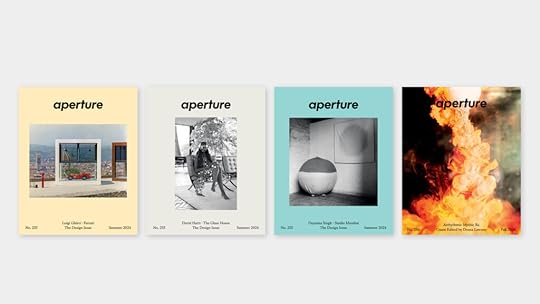
Aperture Magazine Subscription
The source for photography since 1952, Aperture features immersive portfolios, in-depth writing, and must-read interviews with today’s leading artists. This summer, Aperture introduced a new look for the magazine with “The Design Issue.” Numerous luminaries have guest edited issues—including the most recent, “Arrhythmic Mythic Ra,” guest edited by Deana Lawson—among them Wolfgang Tillmans, Tilda Swinton, Alec Soth, Sarah Lewis, Nicole R. Fleetwood, and Wendy Red Star, making the magazine essential reading for anyone interested in photography and contemporary culture.

In the nearly seven decades since its publication in the 1950s, Robert Frank’s The Americans has become one of the most influential and enduring works of American photography. Through eighty-three photographs taken across the country, Frank unveiled an America that had gone previously unacknowledged—confronting its people with an underbelly of racial inequality, corruption, injustice, and the stark reality of the American dream. This year, to mark the centennial of Frank’s birth, Aperture has reissued The Americans, alongside a special centennial edition with a slipcase and featuring a booklet showcasing Frank’s early films.
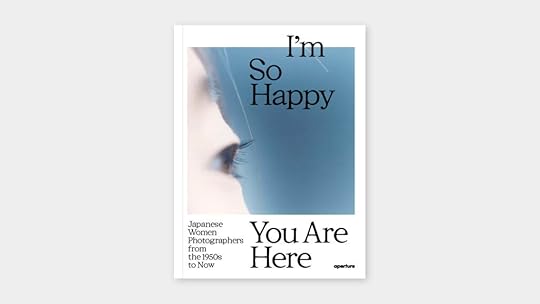
I’m So Happy You Are Here: Japanese Women Photographers from the 1950s to Now
I’m So Happy You Are Here presents a critical and celebratory counternarrative to what we know of Japanese photography today. This restorative history presents a wide range of photographic approaches brought to bear on the lived experiences of women in Japanese society. The volume showcases the work of twenty-five artists whose voices and practices have shaped the medium’s landscape across seven decades, alongside a range of insightful essays and interviews from leading curators and historians.
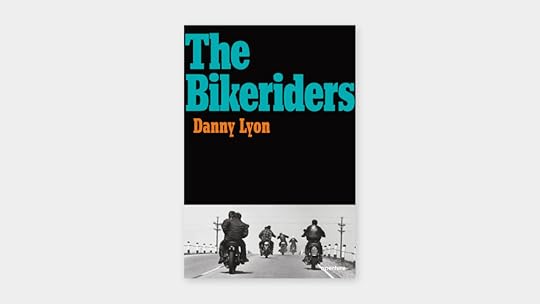
Danny Lyon’s riveting book about a Chicago motorcycle club is one of the definitive accounts of American counterculture. First published in 1968, The Bikeriders offers an immersive look into the Chicago Outlaws Motorcycle Club, bringing together photographs and transcribed interviews by Lyon from 1963 to 1967. The volume was also the inspiration for the 2023 film of the same name starring Austin Butler, Jodie Comer, and Tom Hardy.
Pioneering Voices
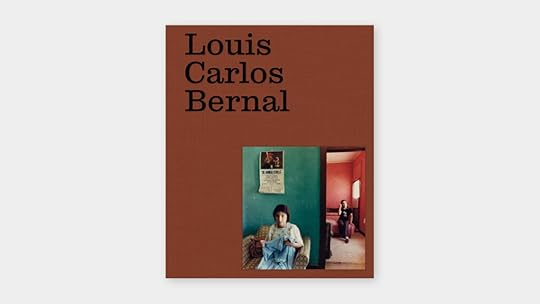
Louis Carlos Bernal: Monografía
Best known for his intimate portrayals of barrio communities of the Southwest United States, Louis Carlos Bernal made photographs in the 1970s and 1980s that draw upon the resonance of Catholicism, Indigenous beliefs, and popular practices tied to the land. For Bernal, photography was a potent tool in affirming the value of individuals and communities who lacked visibility and agency. The first major scholarly account of Bernal’s life and work, Monografía is a landmark survey of one of the most significant American photographers of the twentieth century.
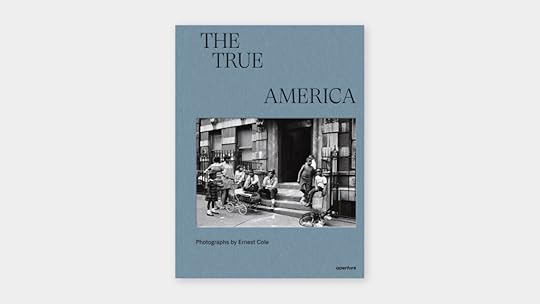
Featuring over 260 unpublished photographs, The True America is the first publication of Ernest Cole’s images depicting Black lives in the US during the turbulent and eventful late 1960s and early 1970s. After fleeing South Africa to publish his landmark book, House of Bondage, in 1967 (reissued by Aperture in 2022) on the horrors of apartheid, Ernest Cole became a “banned person” and resettled in New York. Supported by a grant from the Ford Foundation, Cole photographed throughout New York City’s streets and the rural South. These photographs reflect both the newfound freedom Cole experienced in the US and the photographer’s incisive eye for inequality as he became increasingly disillusioned by the systemic racism he witnessed.

In her searing, diaristic portrait of a city and society in revolution, Myriam Boulos creates an intimate portrait of youth, queerness, and protest. What’s Ours, her debut monograph, brings together over a decade of images, casting a determined eye on the revolution that began in Lebanon in 2019 with protests against government corruption and austerity—culminating with the aftermath of the devastating Beirut port explosion of August 2020. Photographing her friends and family with energy and intimacy, Boulos portrays the body in public space as a powerful symbol of vulnerability and resistance against neglect and violence. “Boulos’s lens inspires and entices her subjects,” writes Mona Eltahawy in an accompanying essay, “they know they have an ally, a secret sharer in their intimacy who then shares them with the rest of us.”

Nan Goldin: The Ballad of Sexual Dependency
Nan Goldin’s iconic visual diary The Ballad of Sexual Dependency chronicles the struggle for intimacy and understanding between her friends, family, and lovers in the 1970s and ’80s. Goldin’s candid, visceral photographs captured a world seething with life—and challenged censorship, disrupted gender stereotypes, and brought crucial visibility and awareness to the AIDS crisis. First published by Aperture in 1986, The Ballad continues to exert a major influence on photography and other aesthetic realms, its status as a contemporary classic firmly established.
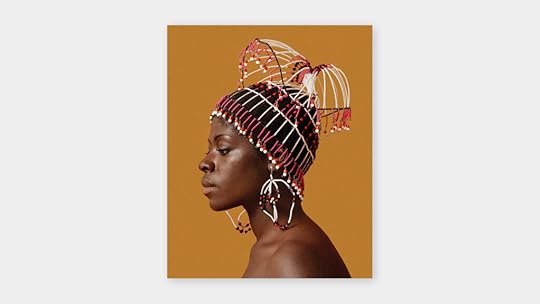
Kwame Brathwaite: Black Is Beautiful
Kwame Brathwaite’s photographs from the 1950s and ’60s transformed how we define Blackness. Using his photography to popularize the slogan “Black Is Beautiful,” Brathwaite challenged mainstream beauty standards of the time. Born in Brooklyn and part of the second-wave Harlem Renaissance, Brathwaite and his brother Elombe were responsible for creating the African Jazz Arts Society and Studios (AJASS) and the Grandassa Models. Until now, Brathwaite has been underrecognized, and Black Is Beautiful is the first-ever monograph dedicated to his remarkable career.
For the Reader
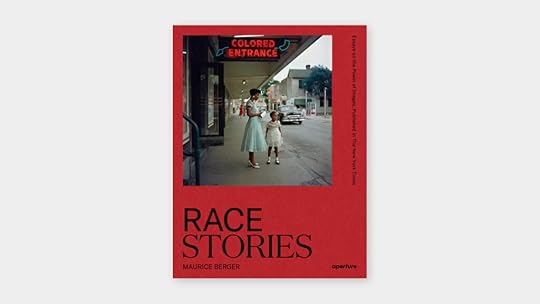
Race Stories: Essays on the Power of Images
Race Stories brings together a collection of award-winning short essays by the late cultural historian Maurice Berger that explore the intersections of photography, race, and visual culture. Edited by Marvin Heiferman, Race Stories features seventy-one essays paired with 120 photographs, examining the transformational role photography plays in shaping ideas and attitudes about race and how photographic images have been instrumental in both perpetuating and combatting racial stereotypes. This volume marks the first title in Aperture’s Vision & Justice Book Series—created and coedited by Drs. Sarah Elizabeth Lewis, Leigh Raiford, and Deborah Willis—which reexamines and redresses historical narratives of photography, race, and justice.

Josef Koudelka: Next is an intimate portrait of the life and work of one of photography’s most renowned and celebrated artists. Drawing from extensive interviews conducted over nearly a decade with the artist and his friends, family, colleagues, and collaborators from around the globe, author Melissa Harris offers an unprecedented glimpse into the mind and world of this notoriously private photographer. Richly illustrated with hundreds of photographs, this visual biography includes personal and behind-the-scenes images from Koudelka’s life, alongside iconic images from his extensive body of work spanning the 1950s to the present.
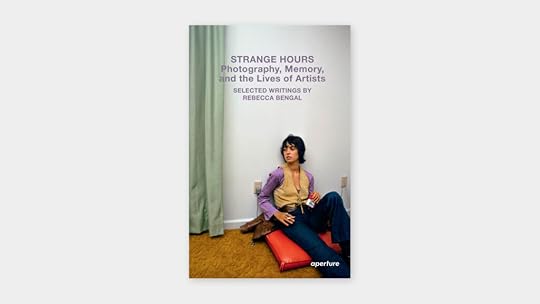
Strange Hours: Photography, Memory, and the Lives of Artists by Rebecca Bengal
In Strange Hours, Rebecca Bengal considers the photographers who have defined our relationship to the medium. Through generous essays and interviews, she contemplates photography’s narrative power, from the radical intimacy of Nan Goldin’s New York demimonde to Justine Kurland’s pictures of rebel girls on the open road. Whether reflecting on her exchanges with William Eggleston or her travels with Alec Soth, Bengal’s prose is attuned to the alchemy of experience, chance, and the vision that has always pushed photography’s potential for unforgettable storytelling.
Contemporary Classics
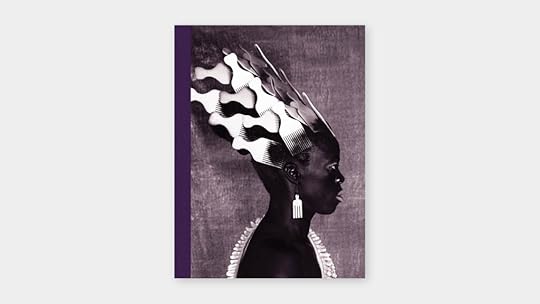
Zanele Muholi: Somnyama Ngonyama, Hail the Dark Lioness, Volume II
In their evocative self-portraits, Zanele Muholi explores and expands upon notions of Blackness and the myriad possibilities of the self. Drawing on different materials or found objects referencing their environment, a specific event, or lived experience, Muholi boldly explores their own image and innate possibilities as a Black person in today’s global society, and speaks emphatically in response to contemporary and historical racisms. Somnyama Ngonyama, Hail the Dark Lioness, Volume II is the follow-up to Muholi’s critically acclaimed first title featuring their self-portraits.

Deana Lawson: An Aperture Monograph
One of the most compelling photographers working today, Deana Lawson portrays the personal and the powerful through her large-scale, dramatic portraits of people in the US, the Caribbean, and Africa. Lawson’s Aperture Monograph is the first photobook by the visionary artist. “Outside a Lawson portrait you might be working three jobs, just keeping your head above water, struggling,” writes Zadie Smith in her essay for the book. “But inside her frame you are beautiful, imperious, unbroken, unfallen.”
Collect a limited edition of Deana Lawson: An Aperture Monograph featuring a special slipcase and custom tipped-in C-print.

In Family Ties, Tina Barney’s keenly observed portraits offer a window into a rarified world of privilege with a sense of spontaneity and intimacy that remind us of what we hold in common. In the late 1970s, Barney began a decades-long exploration of the everyday but often hidden life of the New England upper class, of which she and her family belonged. Photographing close relatives and friends, she became an astute observer of the rituals common to the intergenerational summer gatherings held in picturesque homes along the East Coast. Released upon the occasion of Barney’s first retrospective in Europe, Family Ties brings together sixty large-format portraits from three decades that have defined Barney’s career.
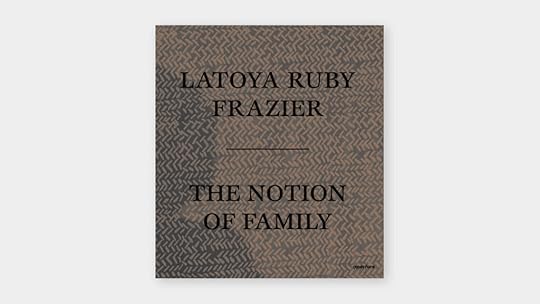
LaToya Ruby Frazier: The Notion of Family
LaToya Ruby Frazier’s award-winning first photobook, The Notion of Family, offers an incisive exploration of the legacies of racism and economic decline in America’s small towns, as embodied by her hometown of Braddock, Pennsylvania. Frazier, whose first major museum survey ran at the Museum of Modern Art, New York, earlier this year, examines the effects of that decline on the community, her own family, and the narratives of the region. Setting the story across three generations—her Grandma Ruby, her mother, and herself—Frazier creates a statement that’s both personal and political.

From hip-hop to Nefertiti, Awol Erizku’s interdisciplinary practice references and reimagines African American and African visual culture while nodding to traditions of spirituality and Surrealism. Mystic Parallax is the first major monograph to span this rising artist’s career. Throughout his work, Erizku consistently questions and reinterprets Western art, often by casting Black subjects in his contemporary reconstructions of canonical artworks. “This goes back to the idea of a continuum of the Black imagination,” Erizku states. “When it’s my turn, as an image maker, a visual griot, it is up to me to redefine a concept, give it a new tone, a new look, a new visual form.” Blending Erizku’s studio practice with his work as an editorial photographer, the volume is accompanied by essays from acclaimed author Ishmael Reed, curator Ashley James, and writer Doreen St. Félix, alongside conversations with Urs Fischer and Antwaun Sargent.
Advertisement
googletag.cmd.push(function () {
googletag.display('div-gpt-ad-1343857479665-0');
});
For the Style- and Design-Inspired
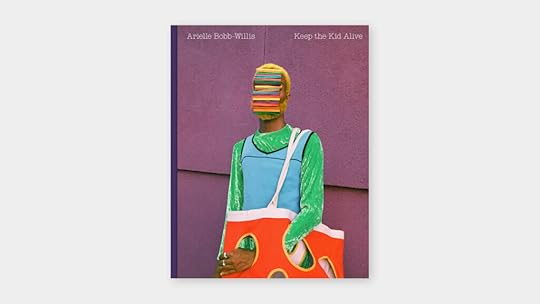
Arielle Bobb-Willis: Keep the Kid Alive
Arielle Bobb-Willis’s first book, Keep the Kid Alive, invites audiences into a brightly imaginative world, filled with dynamic colors, gestures, and unusual poses of the artist’s own creation. Transforming the streets of New Orleans, New York, and Los Angeles into lush backdrops for her wonderfully surreal tableaus, Bobb-Willis makes unforgettable images that expand the genres of fashion and art photography. As Bobb-Willis notes in an interview from the book, “Photography is, and will always be, a daily practice of falling in love with as many things as I can.”

The New Black Vanguard: Photography between Art and Fashion
In The New Black Vanguard, curator and critic Antwaun Sargent addresses a radical transformation taking place in art and fashion today through the work of fifteen contemporary Black photographers who are rethinking the possibilities of representation. Whether on the role of the Black figure in media; cross-pollination between art, fashion, and culture; or the institutional barriers that have historically been an impediment to Black photographers, The New Black Vanguard opens up critical conversations while simultaneously proposing a brilliantly reenvisioned future.
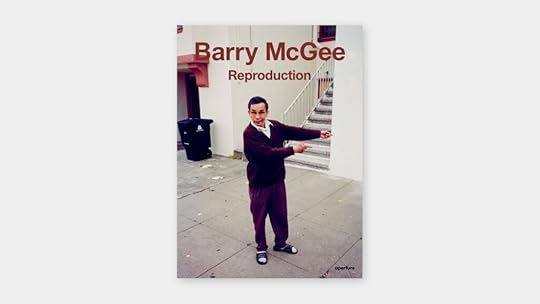
Reproduction is the first monograph to collect the photographs of internationally acclaimed multimedia artist Barry McGee. Throughout his career, McGee has recorded the conspiratorial energy and daring acts of street art, a practice fundamental to his work in painting, drawing, zines, and installation. Reproduction provides unique insight into the process of a major American artist and is a testament to the immense amount of visual information McGee has absorbed throughout his career.
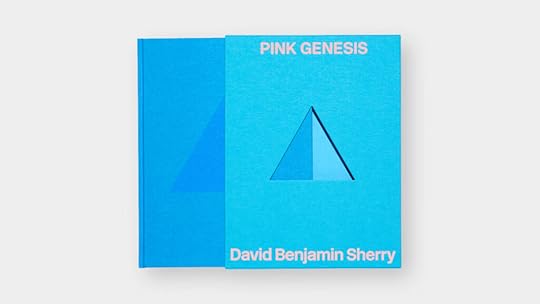
David Benjamin Sherry: Pink Genesis
With his mesmerizing analog photograms, David Benjamin Sherry melds queer history, abstraction, and darkroom magic. Born out of what Sherry has called the “transformative potential of the darkroom,” each of his large-scale, cameraless color photograms is laboriously made by hand in the darkroom. Using cardboard masks to create geometric forms and incorporating his own body into the images, Sherry actively references histories of photography—while also thinking through the intersections of identity, form, and the hypnotic power of extreme color. Pink Genesis collects twenty-nine one-of-a-kind works that delight in the pleasures of form and color.
Give the Gift of Inspiration
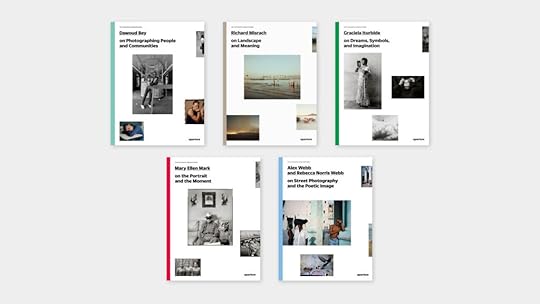
The Photography Workshop Book Series
In our Photography Workshop Series, Aperture works with the world’s top photographers to distill their creative approaches to, teachings on, and insights into photography, offering the workshop experience in a book. Whether showcasing Richard Misrach on landscape photography and meaning; Graciela Iturbide on how to employ a deeply personal vision while also reflecting subjects’ rich cultural backgrounds; or Dawoud Bey on photographing people and communities, these books offer inspiration to photographers at all levels who wish to improve their work, as well as readers interested in deepening their understanding of the art of photography.
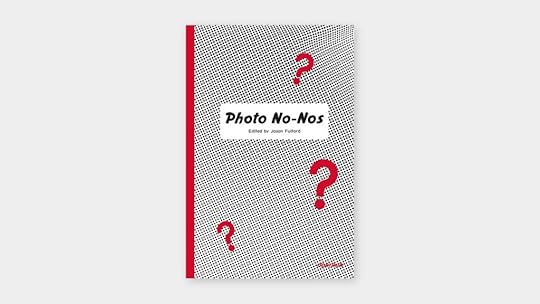
Photo No-Nos: Meditations on What Not to Photograph
What is a “photo no-no”? Photographers often have unwritten lists of subjects they tell themselves not to shoot—things that are cliché, exploitative, derivative, or sometimes even arbitrary. Edited by Jason Fulford, this volume brings together ideas, stories, and anecdotes from over two hundred photographers and photography professionals. Not a strict guide but a series of meditations on “bad” pictures, Photo No-Nos covers a wide range of topics, from sunsets and roses to issues of colonialism, stereotypes, and social responsibility—offering a timely and thoughtful resource on what photographers consider to be off-limits, and how they have contended with their own self-imposed rules without being paralyzed by them.
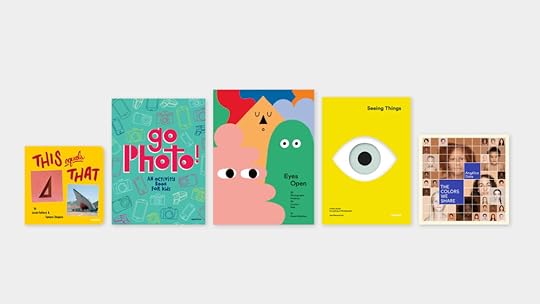
Inspire young readers with three special books that explore the magic of photography. Eyes Open, compiled by Susan Meiselas, is a sourcebook of photography ideas and prompts for children to engage with the world through the camera. Seeing Things serves as a wonderful introduction to photography, with narration by Joel Meyerowitz on how photographers can transform ordinary things into meaningful moments. Aimed at children between eight and twelve years old, Go Photo! features twenty-five hands-on and creative activities inspired by photography.
For the Armchair Traveler

In Wires Crossed, Ed Templeton offers an insider’s look at the skateboarding community as it gained increasing cultural currency in the 1990s and beyond. Part memoir, part document of the DIY, punk-infused subculture of skateboarding, the book reflects on a subculture in the making and the unique aesthetic stamp that sprang from the skate world he helped create. “This book is a culmination of literally my first idea as a photographer, ” Templeton reflects in an interview from the book. “which was to document this culture that I’m part of.”
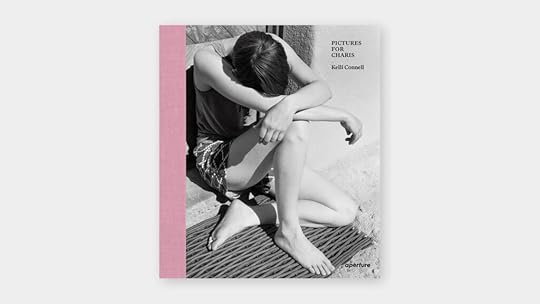
Kelli Connell: Pictures for Charis
In Pictures for Charis, Kelli Connell takes inspiration from the life of Charis Wilson and her collaborations with Edward Weston through the contemporary lens of a queer woman artist. Connell focuses on Wilson and Weston’s shared legacy, traveling with her own partner, Betsy Odom, to locations in the western United States where the earlier couple made photographs together more than eighty years ago. Bringing together photographs and writing by Connell alongside Weston’s classic figure studies and landscapes, Pictures for Charis raises vital questions about photography, gender, and portraiture in the twenty-first century.
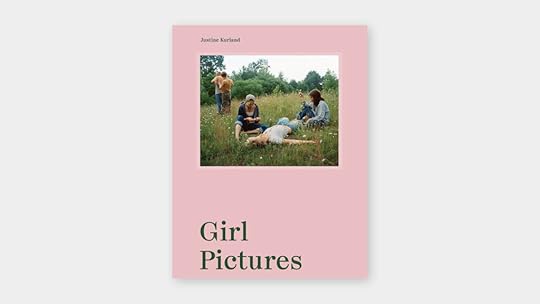
Justine Kurland: Girl Pictures
The North American frontier is an enduring symbol of romance, rebellion, escape, and freedom. At the same time, it’s a profoundly masculine myth: cowboys, outlaws, Beat poets. Photographer Justine Kurland, known for her idyllic images of American landscapes and their fringe communities, sought to reclaim this space with her now-iconic series Girl Pictures. Made between 1997 and 2002, Kurland’s photographs stage scenes of teenage girls as imagined runaways, offering a radical vision of community and feminism.
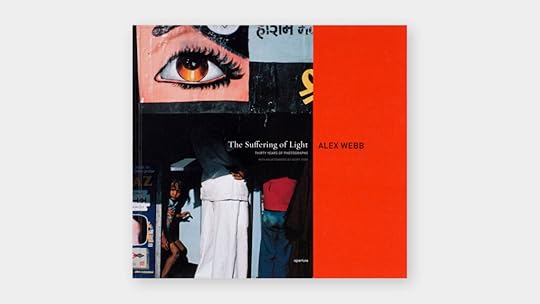
Alex Webb: The Suffering of Light
Since the 1970s, Alex Webb has distilled gesture, light, and color into layered compositions. First published by Aperture in 2011 and newly reprinted, The Suffering of Light touches on multiple genres across Webb’s work, charting the expansive career of the acclaimed photographer. “Not a typical documentary photographer or photojournalist, I’ve worked essentially as a street photographer, exploring the world with the camera, allowing the rhythm and the life of the street to guide and inform the work,” Webb writes in the introduction to the volume. “For me, everything comes, first and foremost, from the street.”
For the Collector
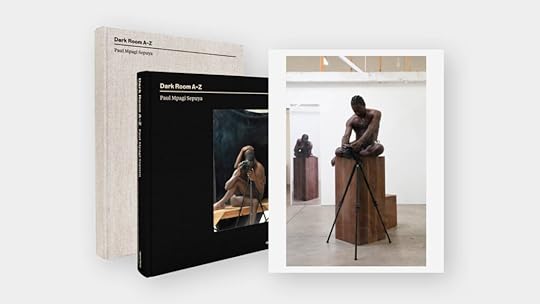
Paul Mpagi Sepuya: Dark Room A–Z, Limited-Edition Book and Print Set
In Dark Room A–Z, Paul Mpagi Sepuya reflects on the methodologies, strategies, and points of interest behind a single, expansive body of work at a pivotal moment in his career. Sepuya’s photography is grounded in a collaborative, rhizomatic approach to studio practice and portraiture. Dark Room A–Z offers a deep dive into the thick network of references and the interconnected community of artists and subjects that Sepuya has interwoven throughout the images. This unique, signed edition of the volume features a clamshell box and limited-edition print by the artist.
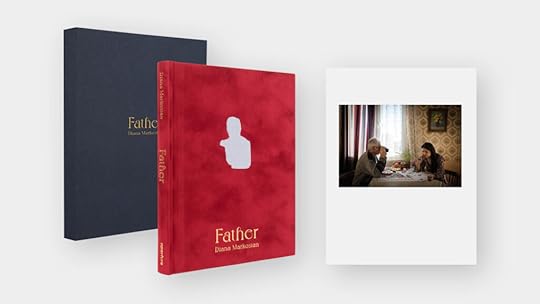
Diana Markosian: Father, Limited-Edition Book and Print Set
Diana Markosian’s Father is an intimate, diaristic portrayal of estrangement and reconnection. Weaving together a mix of documentary photographs, family snapshots, text, and visual ephemera,Markosian attempts to piece together an image of a familiar stranger: her long-lost father. The volume is a follow-up to Markosian’s first book, Santa Barbara, in which the photographer recreates the story of her family’s journey from post–Soviet Russia to the US in the 1990s. Photographing over the course of a decade in her father’s home in Armenia, Markosian explores her father’s absence, their reconciliation, and the shared emptiness of their prolonged estrangement.
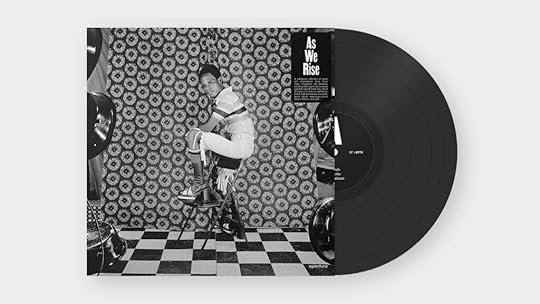
As We Rise: Sounds from the Black Atlantic (LP)
Aperture’s first record release is a celebratory collection of classic and contemporary Black music made throughout the Diaspora, featuring artists such as Jamaican dancehall musician Tenor Saw, North American guitarist Jeff Parker, British funk band Cymande, and South African artist-singer-activist Miriam Makeba. The LP expands upon the ethos of the book As We Rise: Photography from the Black Atlantic, a timely exploration of Black identity on both sides of the Atlantic.
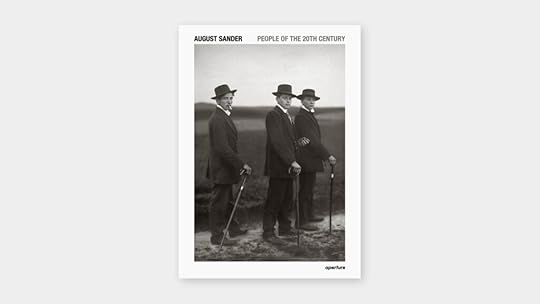
August Sander: People of the 20th Century
A landmark in the history of modern art, People of the 20th Century presents the fullest expression of August Sander’s lifelong work: a monumental endeavor to amass an archive of twentieth-century humanity through a cross-section of German culture. In the 1920s, Sander began to photograph subjects from all walks of life, documenting bankers and boxers, soldiers and circus performers, farmers and families. Sander’s photographs, remarkable for their unflinching realism, provide a powerful social mirror of Germany between the world wars. People of the 20th Century brings together this long out-of-print compendium in an all-in-one volume featuring over six hundred photographs—the most comprehensive iteration of Sander’s still-essential vision.
Shop Aperture’s Holiday Sale now for savings on photobooks, magazines, and limited-edition prints.
November 15, 2024
6 Photographers Reflect on Robert Frank’s “The Americans”
In the nearly seven decades since its publication in France in 1958, then in the US in 1959, Robert Frank’s The Americans has become one of the most influential and enduring works of American photography. Through eighty-three photographs taken across the country, Frank unveiled an America that had gone previously unacknowledged—confronting its people with an underbelly of racial inequality, corruption, injustice, and the stark reality of the American dream. Frank’s point of view—at once startling and tenacious—is imbued with humanity and lyricism, painting a poignant and incomparable portrait of the nation at a turning point in history.
This year, to mark the centennial of Frank’s birth, Aperture has reissued The Americans more than a half century after the 1968 Aperture and Museum of Modern Art edition. This year’s publication coincides with the major exhibition Life Dances On: Robert Frank in Dialogue at the Museum of Modern Art, New York.
Now extolled as one of the most groundbreaking photobooks of all time, The Americans remains as powerful and provocative as it was upon publication and continues to resonate with audiences today. Frank’s exacting vision, distinct style, and poetic insight changed the course of twentieth-century photography—and influenced generations of photographers. Here, six artists choose a photograph from The Americans and reflect on its lasting impact.
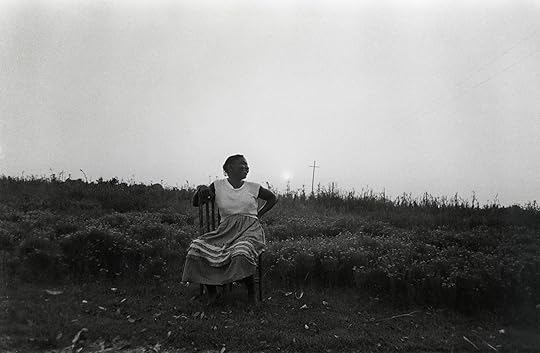 Robert Frank, Beaufort, South Carolina, 1955/56
Robert Frank, Beaufort, South Carolina, 1955/56Dawoud Bey
Through his now famous journey of absolution across the US that he undertook beginning in 1955, Robert Frank sought to take the pulse of America visually. In the induced optimism of the postwar Eisenhower era, Frank saw, with the unvarnished X-ray vision of an attentive newcomer, beneath the veneer of that era’s optimism to see an America beset by social tensions. For one thing, the troubled relations that the country had with its Black citizens—a continuing legacy of slavery—still rested heavily on the landscape. But then, so did those occasional moments of celebratory release, leisure, and self-celebration, such as one he found as a Black woman ended her day one evening in an open field. The sun was beginning to set, and this lone Black woman was reveling in her moment of release from her labors and cares. She found herself a moment of sheer reverie and was witnessed in this moment by a meandering stranger of a decidedly different race and circumstance, who nevertheless in that instant made an image that imbued her presence with an internal lightness and gestural elegance that spoke—and still speaks—to her deeper sense of self.
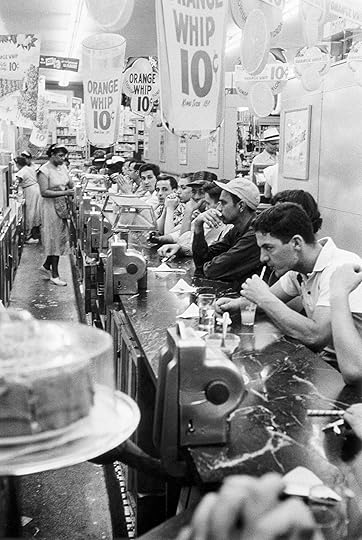 Robert Frank, Drug store — Detroit, 1955/56
Robert Frank, Drug store — Detroit, 1955/56Tommy Kha
This is the first Robert Frank picture I saw in a lecture (Ellen Daugherty’s “History of Photography”). Drug Store—Detroit depicts different kinds of divisions: race, class, but also photographic composition. Every element in this picture is occupied. The eye is redirected constantly—from the multiple, semi-deconstructed orange advertisements suspended in the air to the stark contrast between the waitresses and the row of patrons sitting at the counter. The picture’s only breathing space, next to the women of color behind the counter, is quickly disappearing.
Viewing this image, I want to recall my fondness for the late Wiles-Smith Drug Store in Memphis. This drug store had a lunch counter serving the best tuna melts and shakes and was an echo of bygone days. While I would prefer to idealize these communal spaces and the shared experiences around food, I can’t help but be haunted by the uglier moments the past can evoke and its divisions that persist today in plain sight. Frank’s photograph remains a cautionary tale.
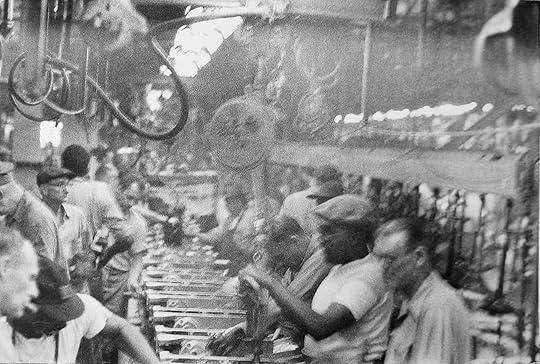 Robert Frank, Assembly line — Detroit, 1955/56
Robert Frank, Assembly line — Detroit, 1955/56Ari Marcopoulos
This is a view of life where a worker’s productivity is all that matters. Working in twenty-four-hour-a-day shifts till your body simply can’t do it anymore. The modern serfs living under kings. The American dream disassembled in one image. The American dream is, in fact, a nightmare.
Advertisement
googletag.cmd.push(function () {
googletag.display('div-gpt-ad-1343857479665-0');
});
 Robert Frank, Rodeo — New York City, 1955/56
Robert Frank, Rodeo — New York City, 1955/56Katy Grannan
I remember where I was standing and the quality of the light the day I first picked up the book that changed everything. There was a before and after, and all the revelations in between its pages were so powerful that I walked away from a career in medicine and chose photography instead. I had never seen anything like The Americans—the poetry, the formal intelligence, the unrelenting critique, and the humanity of Robert Frank’s work were so beautiful and messy and unafraid. Words are a poor approximation, but since Aperture asked, I’ll say this photograph of a cowboy leaning against a trash can is something else. Its meaning only starts within the frame—the cowboy’s tight-fitting jeans are carefully tucked into hand-tooled boots, his long legs extended and crossed casually as though anticipating an audience. It seems the Marlboro Man has lost his way, his horse replaced by a trash can. Never mind the concrete backdrop, this wayward mythic figure is a Believer, attending to every sartorial detail, gesture, and pose.
Kristine Potter
There’s much to admire in The Americans, but I’ve always particularly loved the portrait of the cowboy in Rodeo — New York City. Frank captures a moment of dislocation—a man dressed in the rugged attire of the American West, standing alone on a city street. His cowboy hat, boots, and belt buckle evoke the myth of the fearless, independent figure, yet here, he seems out of place. His head is bowed, hands adjusting his shirt in a small, vulnerable gesture that contrasts sharply with the boldness we associate with this iconic role. The urban environment surrounds him, indifferent to his presence, while he remains isolated from it, leaning against a wire trash can as though caught between worlds. I’m particularly drawn to the tension between myth and reality, which runs throughout Frank’s work. He reveals how twentieth-century symbols like the cowboy, the car, and the drive-in unravel—whether through shifts in context, changing cultural landscapes, or because the myths were always fragile. Yet, in stripping away the layers of these American ideals, Frank was not only exposing their complexities but also deconstructing them. Frank was perceptive enough to recognize these symbols even as they were being formed.
 Robert Frank, View from hotel window — Butte, Montana, 1955/56
Robert Frank, View from hotel window — Butte, Montana, 1955/56Alec Soth
Like countless photographers inspired by Robert Frank, I’ve visited Butte, Montana, and been seduced by its faded western grandeur. I’ve even made the devotional pilgrimage to the room where he took his picture at the Finlen Hotel and Motor Inn. Needless to say, the picture I took wasn’t memorable. What makes Frank’s image special is less what’s described than the aura of its author. The somber hotel view has depth because we step into the shoes of the road-weary traveler.
See more in Robert Frank: The Americans (Aperture, 2024).
Hervé Guibert’s Seductive Photo-Novel About Two Sisters in Reclusion
Hervé Guibert is best known for autobiographical novels, such as To the Friend Who Did Not Save My Life (1990), published the year before he died from AIDS-related complications at the age of thirty-six. But Guibert was also passionate about another means of turning life into art: photography. This is evidenced not only by the many recent exhibitions of his work and his essential book Ghost Image (1982)—a carnal response to Roland Barthes’s Camera Lucida—but equally by the photo-novel Suzanne and Louise, first published in 1980 and finally now appearing in an English translation by Christine Pichini. As Moyra Davey notes in her introduction to the new edition, the book is “a prized rarity” in that it is Guibert’s “only monograph where his full gifts as an image maker and as a writer combine.” The nature of that combination is at turns seductive, touching, and clever—but it is never straightforward.
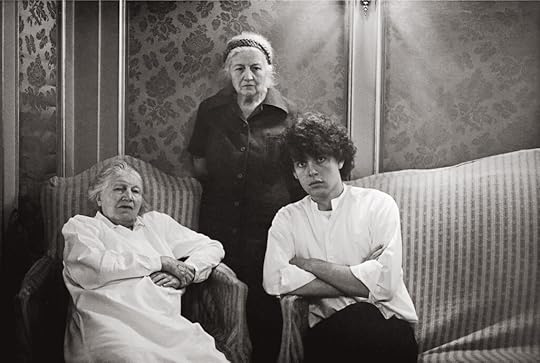
Suzanne and Louise is a story of devotion and desire. Almost all its images are domestic portraits of the titular sisters, the author’s great-aunts, who live together in a hôtel particulier in Paris’s fifteenth arrondissement. Guibert tells the tale of these women and offers glimpses of their lives, defying their idea that “old age isn’t presentable.” The pictures are posed but devoid of any great artifice; they possess a candor that is telegraphed above all by how often the pair is seen with their long gray hair—“the most intimate thing,” Guibert writes—set free to flow down backs that stoop with the weight of years. Ingenuous disclosure, one might think. While this would not be entirely wrong, the book’s first image points in a different direction. It depicts not Suzanne and Louise but studio portraits of each woman at a younger age, both of which are partially obscured by other images tucked into their frames. Likenesses multiply; any direct access to the pharmacist’s widow and the ex-Carmelite nun splinters into a field of competing depictions. This initial photograph of photographs is a clue that, rather than an immodest divulgence, Suzanne and Louise will be an intricate choreography of privacy, revelation, and performance, keenly testing the possibilities of its hybrid medium.

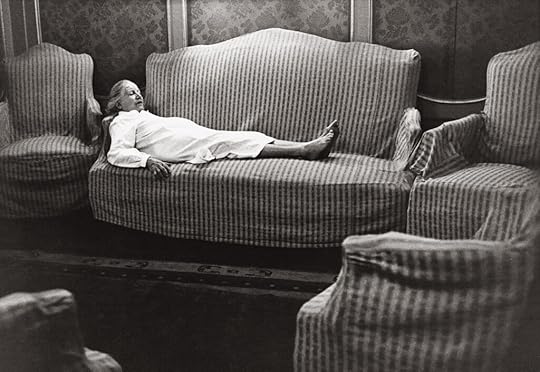
Guibert is known for telling all, for dragging all his life into the frame without shame, in ways tender and brutal. In La pudeur et l’impudeur (1992), his sole moving-image work, he subjects his emaciated body to the camera’s stare. Suzanne and Louise, intermittent protagonists in their grandnephew’s oeuvre since the photo-novel twelve years before, also appear in the video, fielding questions from him such as “Do you want to live or do you want to die?” (Suzanne’s answer: “It depends on the moment.”) This refusal to accept normative prescriptions of what deserves a place within representation—and what does not—sits at the heart of Guibert’s AIDS autofictions, and is no less present in Suzanne and Louise, despite its radically different subject matter. The book likewise plunges into an everyday that might otherwise be invisible, into lives lived at a distance from the heterosexual family and in palpable proximity to death. The intergenerational bond between the queer twentysomething and his great-aunts short-circuits patriarchal authority.
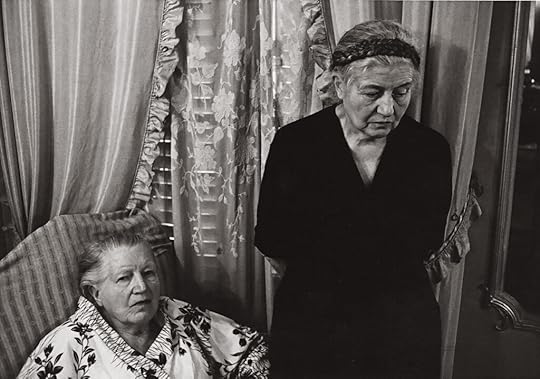
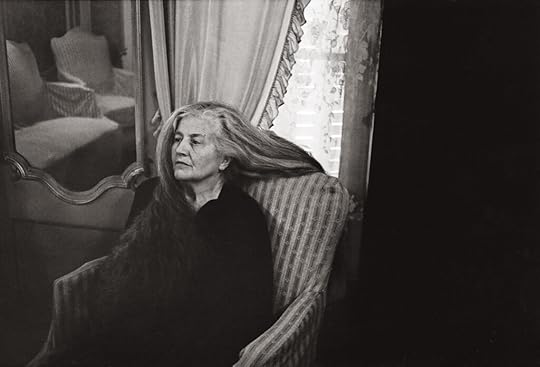 All photographs by Hervé Guibert from Suzanne and Louise (Magic Hour Press, 2024)
All photographs by Hervé Guibert from Suzanne and Louise (Magic Hour Press, 2024)The book’s texts have a diaristic quality that is heightened in the French edition, where they appear in Guibert’s own handwriting, tethering word to body. Yet alongside Suzanne and Louise’s many inscriptions of presence is a predilection for absence, dream, and fantasy—in other words, for fiction. The German shepherds Whysky and Amok are central to the text but remain unseen, with their only visible trace coming in two anomalous pictures in which Louise poses with their muzzle over her face. In an echo of Ghost Image, there are descriptions of nonexistent photographs, missing images that haunt through words. And as the book progresses, a complicated account unfolds of Guibert’s shifting attempts to represent his great-aunts across media, from an unrealized film and a play never publicly performed, to an exhibition that ultimately sparks the creation of a photo-novel that concludes with fragments of a script for a new movie. Plans change in response to myriad factors, not least of which is the women’s reticence to have the details of their cloistered existence made known. By the end, it is clear that the entire enterprise has been one of tremendous complicity, a conspiracy of three more than an unobtrusive picturing of two.
“I am afraid of spiders, but not afraid of the presence of the dead,” Guibert writes. That presence is everywhere throughout Suzanne and Louise, and not only because the women are getting on in age. Guibert describes images never taken of a euthanized Whysky; he offers multiple evocations of Suzanne’s death, whether in a dream, a series of staged photographs, a film script, or the idea of one day photographing her corpse. He clings to representation as a talisman that will ward off the inevitable—but to vanquish finitude, he must invite it in. The fourth protagonist of this singular work, a book caught between conceptualism and confession, is death itself.
Herve Guibert’s Suzanne and Louise was published by Magic Hour Press in 2024.
November 14, 2024
In the Mythic Mediterranean, a Labyrinth of Female Creativity
Cinephiles might recognize the pristine beaches of Porquerolles from Jean-Luc Godard’s 1965 film Pierrot le fou. The small island just off France’s southern coast is a national park with little development—no cars, few houses—but abundant natural splendor, and in our age of far-flung destination art locations, there is also an arts foundation with a compelling program and collection. The Fondation Carmignac is the vision of Édouard Carmignac, who in 2018 adapted an old villa into an exhibition space, which sits serenely amid the sea, forest, and vineyards.
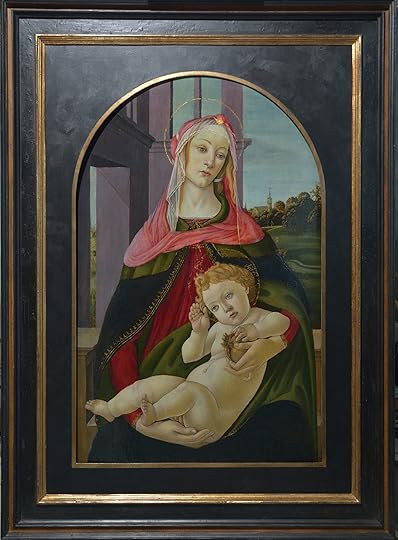 Sandro Botticelli, Madonna of the Pomegranate, 1445–1510
Sandro Botticelli, Madonna of the Pomegranate, 1445–1510Courtesy Collection Carmignac
This past summer, the foundation opened The Infinite Woman, a sprawling exhibition organized by curator Alona Pardo, assembling work by sixty-six artists (mostly women) working in all manner of media. This eclectic, multigenerational selection engaged with a multiplicity of ways of considering representations of women, the feminine, and the mythological. As Pardo explains, “The exhibition seeks to disrupt and question the archetypal representation of womanhood by proposing woman as a creative force, a sexual being, a pleasure-seeker, while dismantling accepted standards of beauty and rethinking the concept of woman altogether.” An ambitious endeavor, for sure, and the island location offered an appropriate stage. Porquerolles’s origin story is steeped in dramatic and gendered mythology (as with much maritime lore): A woman fleeing a male predator transformed into the island, giving form to the land. Across the show, figures of women appear as creators, world-builders, life-givers, and shapeshifters across centuries of art making, from a fifteenth-century Botticelli painting of the Madonna and Child greeting visitors at the gallery’s entrance, to the recent hypnotic, anthropomorphic relief paintings by Loie Hollowell and the otherworldly watercolors of Chioma Ebinama.
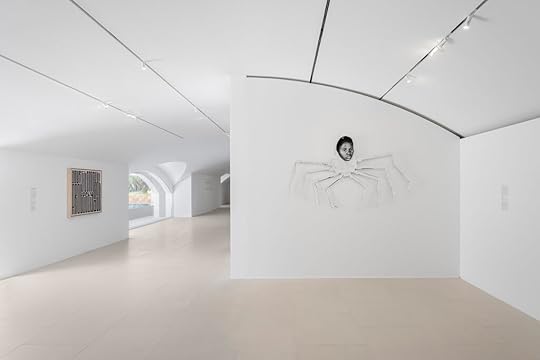 Frida Orupabo, Untitled (Spider II), 2022
Frida Orupabo, Untitled (Spider II), 2022Courtesy Stevenson, Cape Town/Johannesburg. Photograph by Nicolas Brasseur/Fondation Carmignac
 Still from Sin Wai Kin, A Dream of Wholeness in Parts, 2021
Still from Sin Wai Kin, A Dream of Wholeness in Parts, 2021Courtesy the artist; Chi-Wen Gallery, Taipei; and Soft Opening, London
Structured around six categories—“Of Myths and Monsters” and “Disobedient Bodies” to name two—painting and sculpture dominated, with some notable photography sprinkled throughout. Spider II, 2022, a photo-collage by Nigerian Norwegian artist Frida Orupabo, foreshadowed a towering arachnid sculpture by Louise Bourgeois, and features the head of a Black woman montaged onto a chalky white spider’s body. Orupabo finds and collects her source imagery on the internet, using keywords such as “colonial vintage images,” to invent chimeras from charged historical material.
Much of the photographic work arrived later in the exhibition, in the thematic sections around desire and queer representation, attesting to both the camera’s role in objectification and the production of desire, as in the distorted pornographic images by Thomas Ruff, and its role in asserting or rescripting identity, as in Zanele Muholi’s crisp black-and-white portraits of trans women, or by exploding gender categories altogether, as in Martine Gutierrez’s stately “anti-icon” self-portraits that reimagine storied historical figures. Here, the artist appears in a retelling of Joan of Arc, with sword, breasts, and penis. A Dream of Wholeness in Parts, a 2021 film by Sin Wai Kin, plays with references to drag, traditional Chinese dramaturgy, and the image of the goddess Venus.
 Kiana Hayeri, Kabul, Afghanistan, February 3, 2024
Kiana Hayeri, Kabul, Afghanistan, February 3, 2024Courtesy Fondation Carmignac
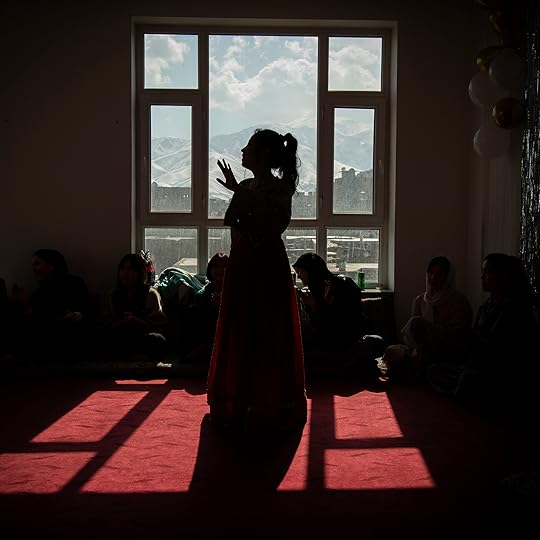 Kiana Hayeri, Kabul, Afghanistan, February 23, 2024
Kiana Hayeri, Kabul, Afghanistan, February 23, 2024 The broader work of Fondation Carmignac is, perhaps surprisingly, at least in formal contrast, dedicated to documentary. The recently announced fourteenth edition of their prestigious photojournalism prize was awarded to Canadian Iranian photojournalist Kiana Hayeri and French researcher Mélissa Cornet, who recently investigated the lives of women and girls across seven provinces in Afghanistan, following the Taliban’s return to power in 2021. Predictably, the project, No Woman’s Land, addressed the rollbacks on education and other freedoms for women, after twenty years of feckless US-led intervention. The extended captions for the project describe a bleak reality of child marriage, surveillance, and control, but the images also reveal quiet resilience in fleeting moments: dancing in the privacy of home, a torn poster instructing women to cover their faces, girls playing in a snowstorm. If the show at the Fondation was a celebration of the infinite possibilities of womanhood, Hayeri’s images offer a stark reminder of the infinite ways in which patriarchy has projected stifling control.
The Infinite Woman was on view at Villa Carmignac, Porquerolles Island, Hyères, France, April 26–November 2, 2024. No Woman’s Land is presented as part of the PhotoSaintGermain festival and on view at Réfectoire des Cordeliers, Paris, through November 18, 2024.
Aperture's Blog
- Aperture's profile
- 21 followers



